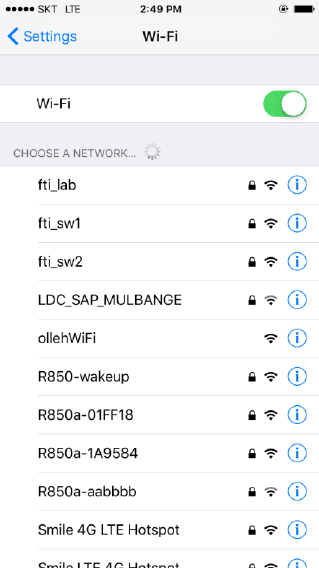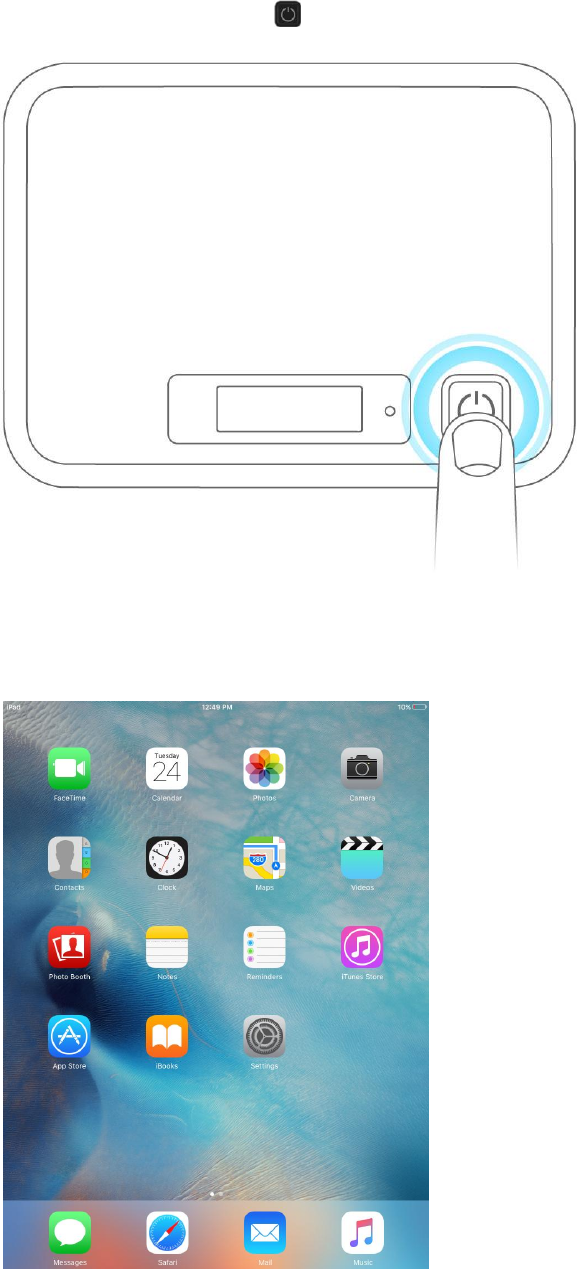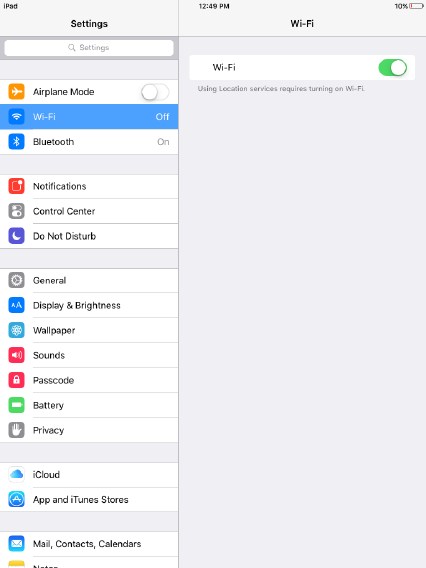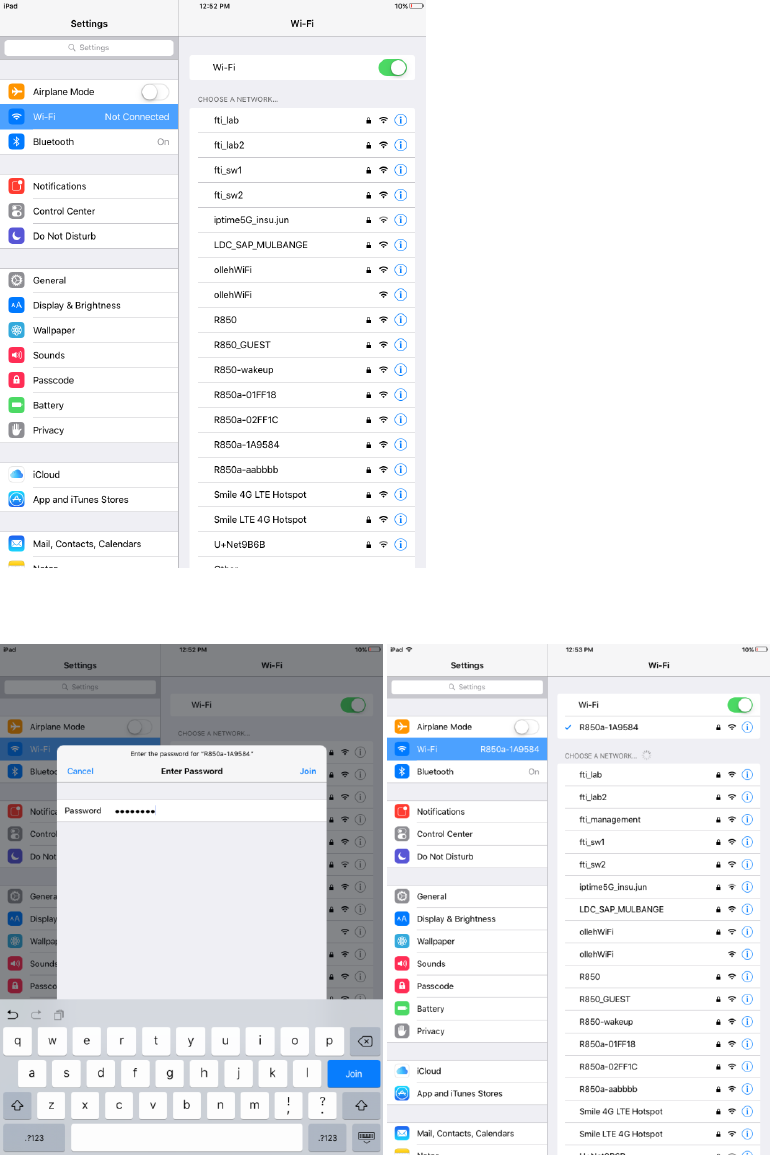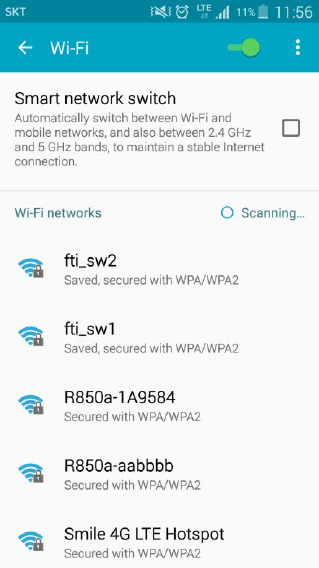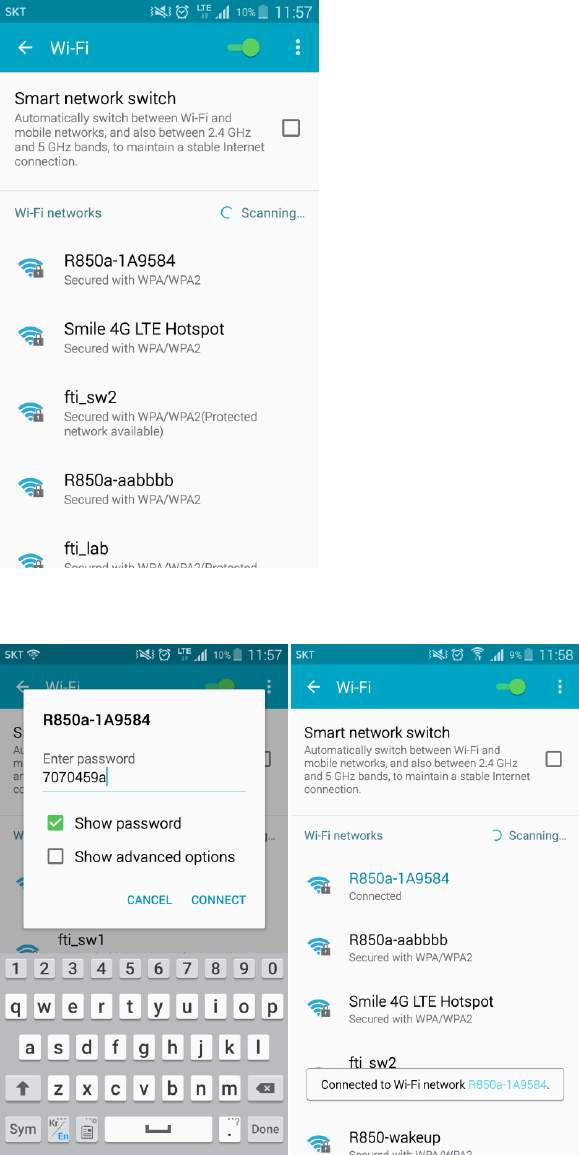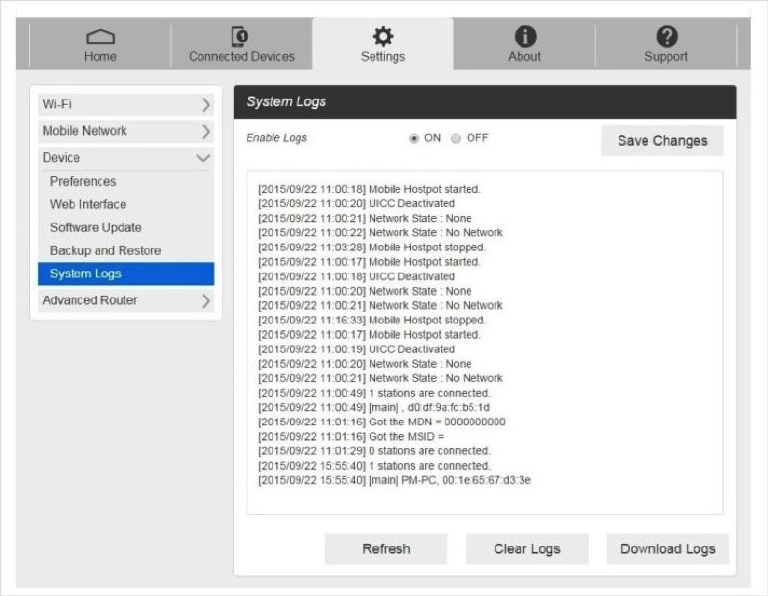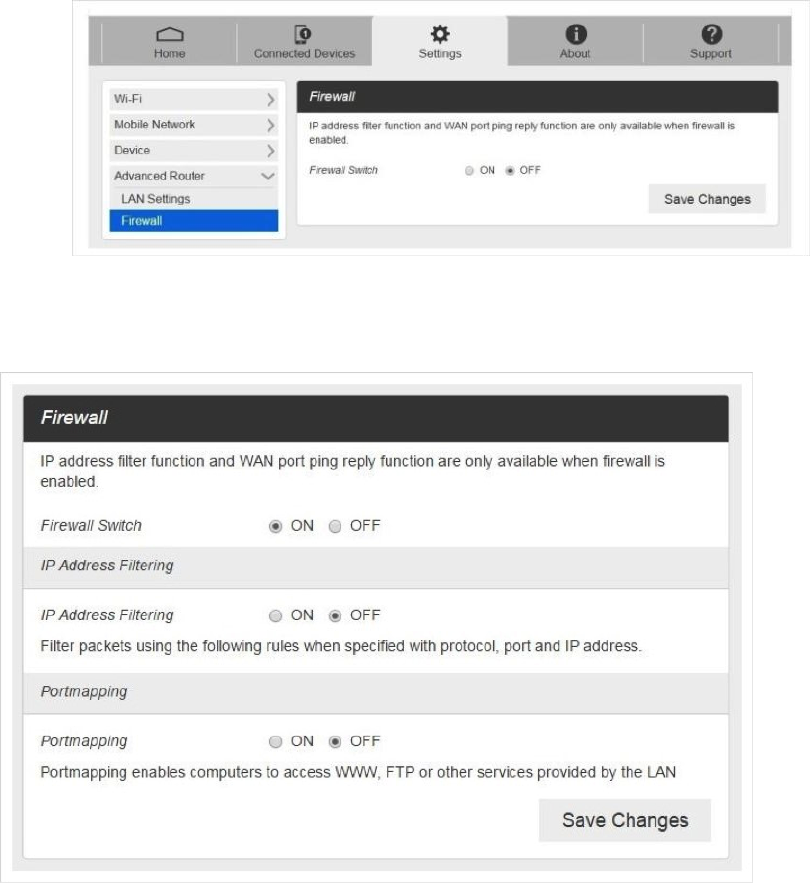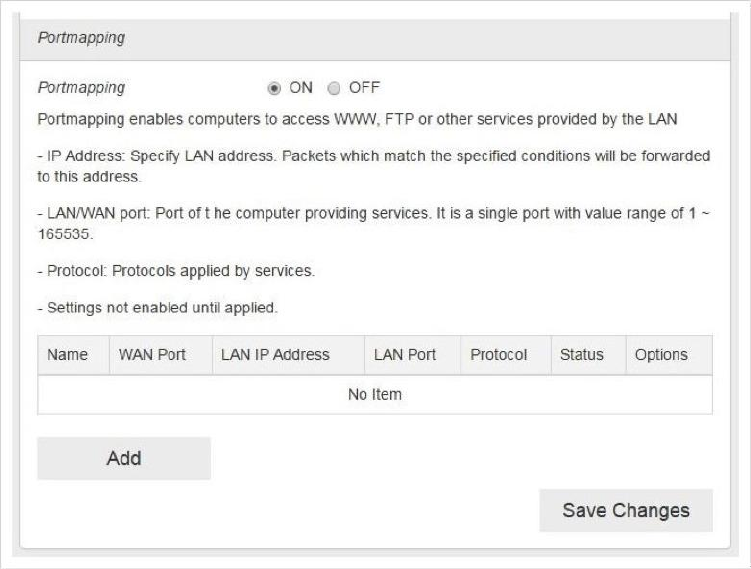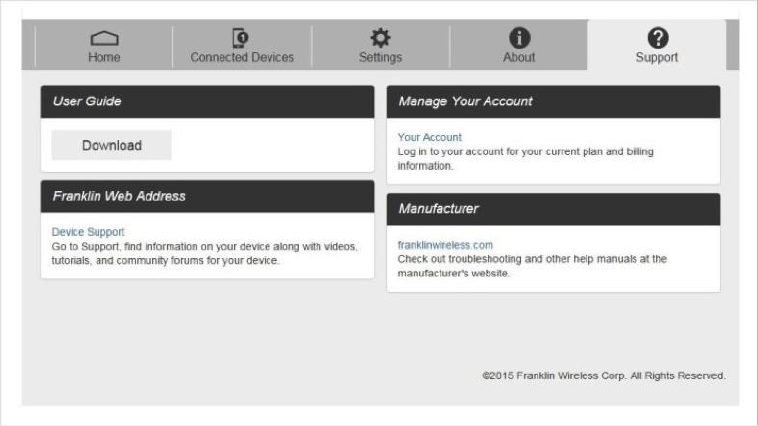Franklin Technology R850 LTE Mobile Router User Manual
Franklin Technology Inc. LTE Mobile Router Users Manual
Users Manual
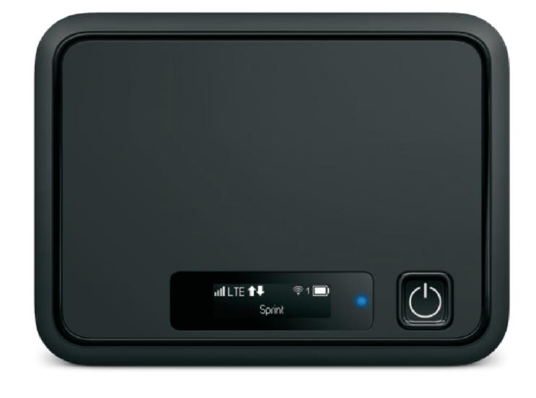
TOC i
R850 Mobile Hotspot
User Guide
UG _ temp version
[Version 1.3.1]
[Sprint_Franklin_Wireless_R850_english_113015_v1.3.1]

TOC ii
Table of Contents
Before You Begin .................................................................................................................................. 4
Compatible Operating Systems (OS).................................................................................................... 5
Package Contents ................................................................................................................................. 5
SSID and Security Key ......................................................................................................................... 6
Additional Information ........................................................................................................................... 6
Parts and Functions .............................................................................................................................. 7
Home Screen ........................................................................................................................................ 8
Home Screen Layout .................................................................................................................... 8
Status Bar Icons ............................................................................................................................ 9
Data Transfer Volume and Transfer Speed .......................................................................................... 9
SIM Card ............................................................................................................................................... 9
Handling a SIM Card ................................................................................................................... 10
Insert a SIM Card ........................................................................................................................ 11
Remove the SIM Card ................................................................................................................ 12
Battery Use ......................................................................................................................................... 15
Insert the Battery ......................................................................................................................... 15
Remove the Battery .................................................................................................................... 16
Charge the Battery ...................................................................................................................... 17
Turn Your Device On and Off ............................................................................................................. 19
Wi-Fi (WLAN) Overview ...................................................................................................................... 22
Activate Wi-Fi (WLAN) Function ......................................................................................................... 22
Connect Windows PCs with Wi-Fi ...................................................................................................... 23
Windows 8................................................................................................................................... 23
Windows 7................................................................................................................................... 25
Connect Mac Computers with Wi-Fi ................................................................................................... 27
Connect iPhone/iPod Touch/iPad ....................................................................................................... 28
Connect an iPhone or an iPod Touch ......................................................................................... 28
Connect an iPad ......................................................................................................................... 31
Connect an Android™ Device ............................................................................................................. 35
Web UI Overview ................................................................................................................................ 39
Web UI Window .................................................................................................................................. 39
Home ................................................................................................................................................... 40
TOC iii
Connected Devices ............................................................................................................................. 40
Settings Tab ........................................................................................................................................ 42
Wi-Fi Basic Settings .................................................................................................................... 42
Wi-Fi Advanced Settings ............................................................................................................. 45
Mobile Network Settings ............................................................................................................. 46
Device Settings ........................................................................................................................... 49
Advanced Router Settings .......................................................................................................... 53
About ................................................................................................................................................... 59
Support Tab ........................................................................................................................................ 60
Troubleshooting .................................................................................................................................. 61
Specifications ...................................................................................................................................... 62
Warranty and Service ......................................................................................................................... 64
Warranty ...................................................................................................................................... 64
Services ...................................................................................................................................... 65
Customer Service ............................................................................................................................... 65
Trademarks and Copyrights ................................................................................................................ 65
Safety Precautions .............................................................................................................................. 66
Important Notice .......................................................................................................................... 66
Safety and Hazards .................................................................................................................... 66
Proper Battery Use and Disposal................................................................................................ 67
FCC Compliance ......................................................................................................................... 67
RF Exposure Information and Specific Absorption Rate (SAR) Information ...................................... 68
Index ............................................................................................................................................................ 69

Index 4
Introduction
The following topics describe the basics of using this guide and your new mobile broadband device.
Before You Begin
Thank you for purchasing your new R850 Mobile Hotspot. The following topics explain how best to use
this guide to get the most out of your mobile broadband device.
Before Using Your Device
Read Safety and Notices thoroughly for proper usage.
Accessible services may be limited by subscription contract conditions.
Guide Usage Notes
Note that most descriptions in this guide are based on your device's default settings at the time of
purchase.
Screenshots and Key Labels
Screenshots and Key labels are provided for reference only. Actual windows, menus, etc. may differ in
appearance.
Other Notations
In the user guide, the mobile broadband device may be referred to either as "mobile broadband device,"
"hotspot," "device," or "Wi-Fi router." A microSD™ or microSDHC™ card is referred to as an "SD Card" or
a "memory card."

Index 5
Compatible Operating Systems (OS)
The table below outlines the compatible operating systems (OS) for your device. Use outside these
environments may affect performance. Additional factors (hardware, connected peripherals, installed
applications, etc.) may also affect performance.
● For computer support, OS version upgrade information, etc., see the corresponding
manufacturer's product support documentation.
● [Feb. 20`5]. Check [Compatible OS] for the latest information in regards to operating environment.
Item
Description
Compatible operating systems (OS)
Windows 7, 8, 10
MacOS 10.5 or later
Android 2.1 or later
Compatible browsers
Chrome 36.0 or later
Internet Explorer 8.0 or later
Firefox 3.1 or later
Safari 5.0 or later
Package Contents
See below for details on everything you will find in the box for your R850.
● R850 Mobile Hotspot
● Battery Cover
● Rechargeable Battery
● AC Adapter
● Get Started Guide
● Important Information Booklet
Index 6
SSID and Security Key
Before connecting Wi-Fi devices to your R850, you will need to confirm the WiFi Name and WiFi
Password.
■ Once your device is completely powered on, press the menu button 1 time for the WiFi Name and
twice to obtain WiFi Password specific to your device
You will see the WiFi Name (SprintWiFia-XXXXXX) and WiFi Password.
Additional Information
The following list describes additional information useful to know before you begin using your R850.
● Your mobile broadband device accommodates software updates. Always use the latest software.
● Note that connection speeds may drop or connections may be disabled depending on line traffic
or connection environments.
● When using WLAN overseas, change the settings according to the laws of those countries.
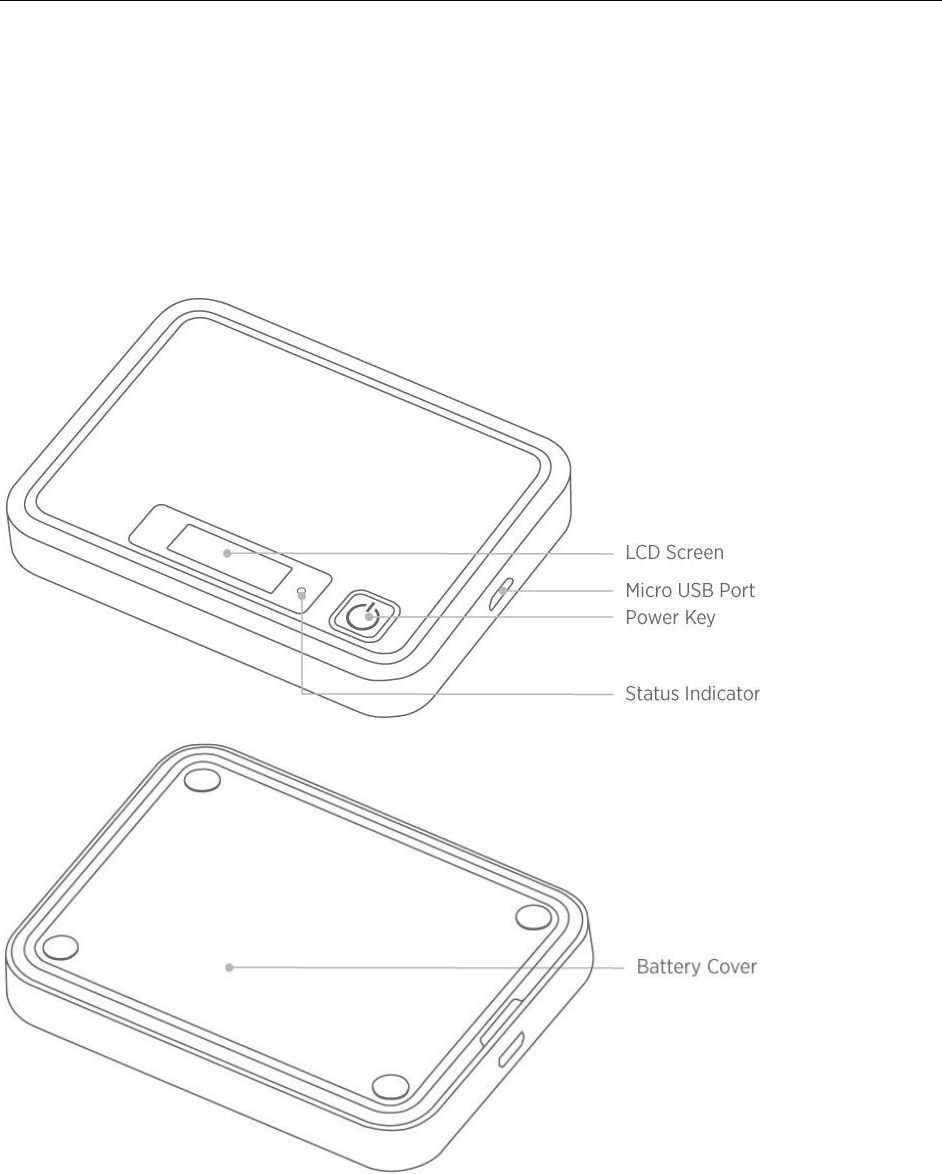
Index 7
Get Started
The following topics give you all the information you need to set up your device and wireless service the
first time.
Parts and Functions
Learn your device's primary parts and functions.
Device Layout
The following illustration outlines your device's primary external features and buttons.
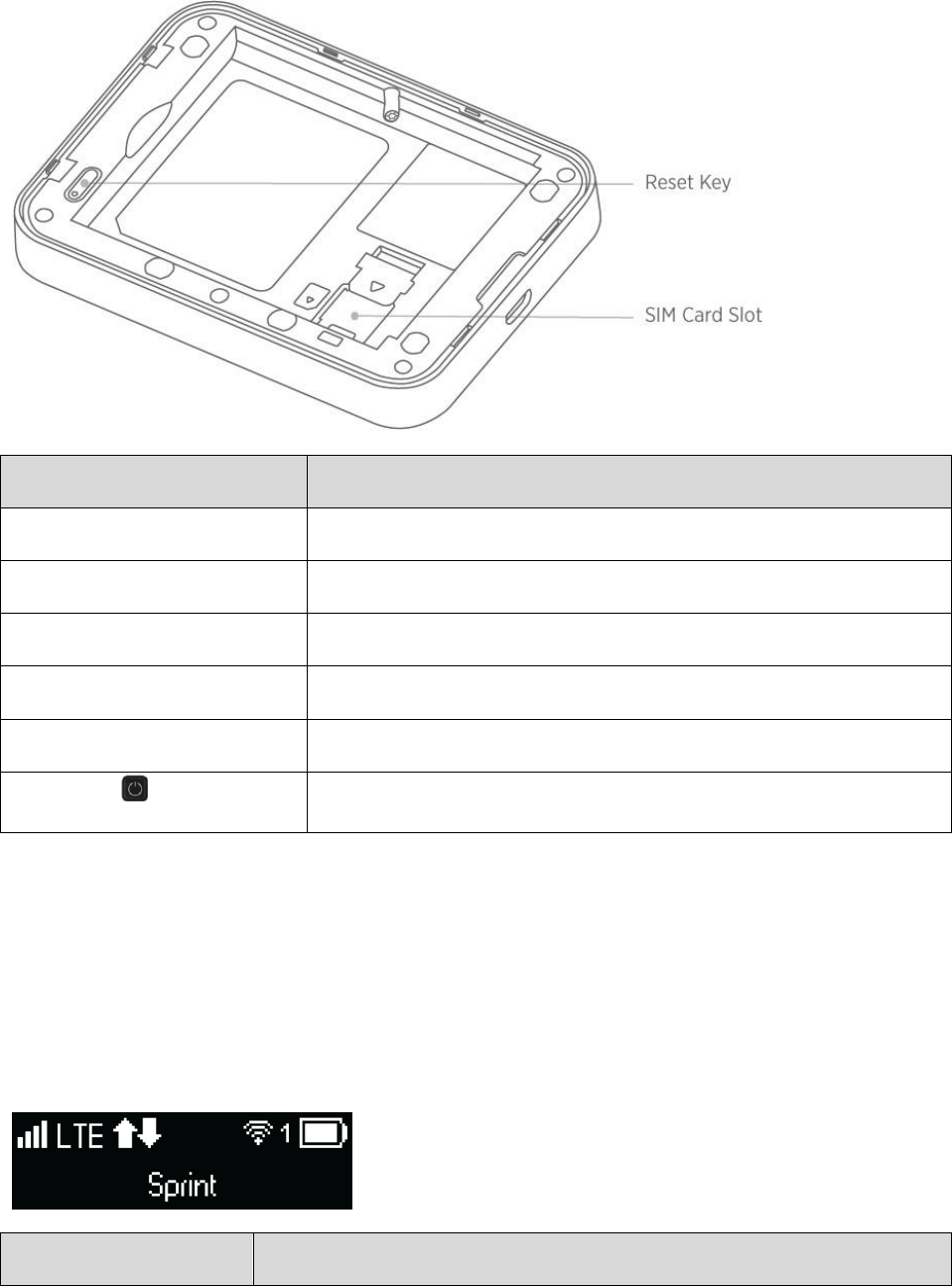
Index 8
Part
Description
LCD Screen
View device status.
SIM card slot
Install the SIM card.
Charging Port
Connect the micro USB cable for charging.
Battery cover
Remove the battery cover to remove or insert the battery or SIM card.
Reset key
Press to reset your device to its default settings.
Power key
Toggle power on or off.
Home Screen
The following topics describe the details of your device's home screen layout, icons, touchscreen usage,
and text entry.
Home Screen Layout
Explore your device's home screen layout.
Part
Description
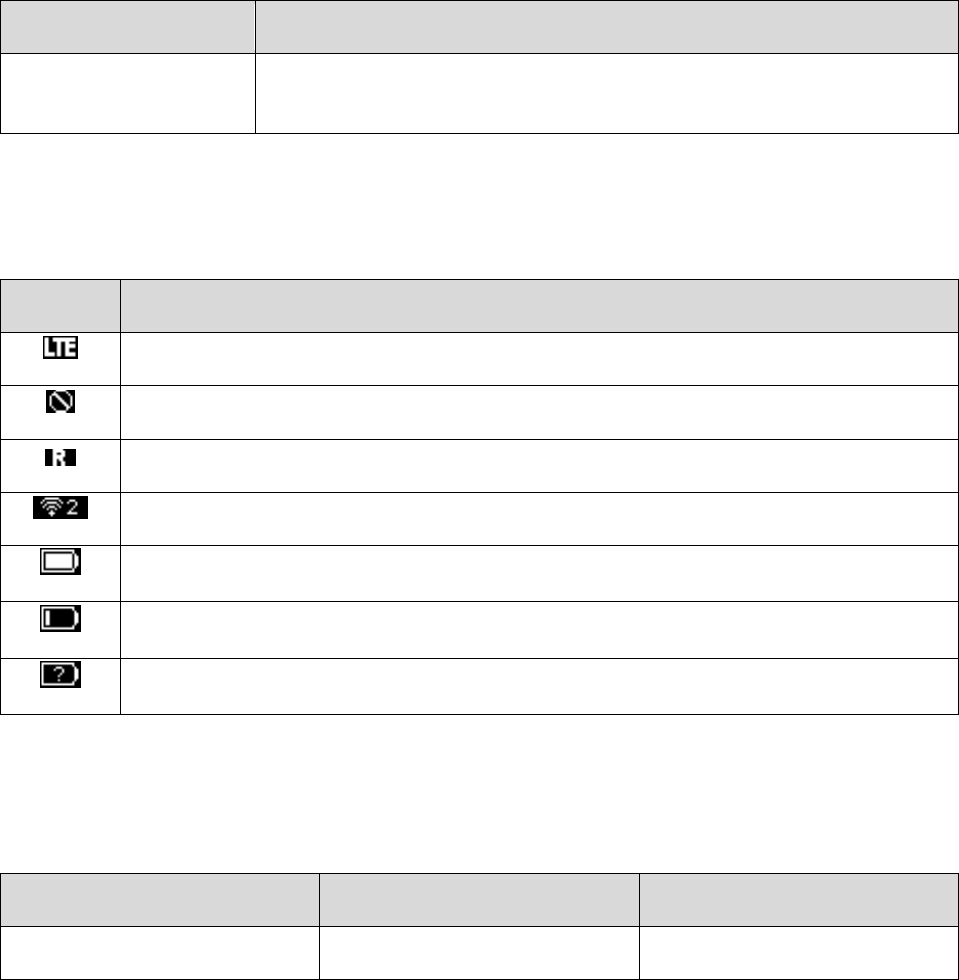
Index 9
Part
Description
Status bar
Displays status indicators including connection status, signal strength,
devices connected, battery level, and more.
Status Bar Icons
The home screen's status bar may feature the following icons, depending on current status.
Icon
Description
Mobile networks connected
Out of service area
Appears when roaming
Connected WLAN devices
Battery full
Battery low
No battery (charging required)
Data Transfer Volume and Transfer Speed
Wireless Mode
Maximum Downlink Speed
Typical Downlink Speed
4G LTE
150 Mbps
50 Mbps
Note: Actual speeds depend on several factors, including network conditions.
SIM Card
The SIM card is an IC card containing your device's phone number and other customer information.
Note: Your device's SIM card is preinstalled.
Index 10
Handling a SIM Card
Keep the following in mind when handling a SIM card.
● Customer is responsible for any damage caused by inserting the SIM card in another-brand IC
card reader, etc. The company is not responsible in such case.
● Always keep the IC chip clean.
● Wipe clean with a dry, soft cloth.
● Avoid applying labels. May damage the SIM card.
● See instructions included with the SIM card for handling.
● The SIM card is the property of the company.
● The SIM card is replaceable (at cost) in case of loss/damage.
● Return the SIM card to the company when cancelling subscription.
● Returned SIM cards are recycled for environmental purposes.
● Note that SIM card specifications and performance may change without notice.
● It is recommended that you keep a separate copy of information that is stored on the SIM card.
The company is not responsible for damages from stored information that is lost.
● Always follow emergency procedures to suspend service if your SIM card or device (SIM card
inserted) is lost or stolen. For details, contact Customer Service.
● Always power off the mobile broadband device before inserting or removing the SIM card.
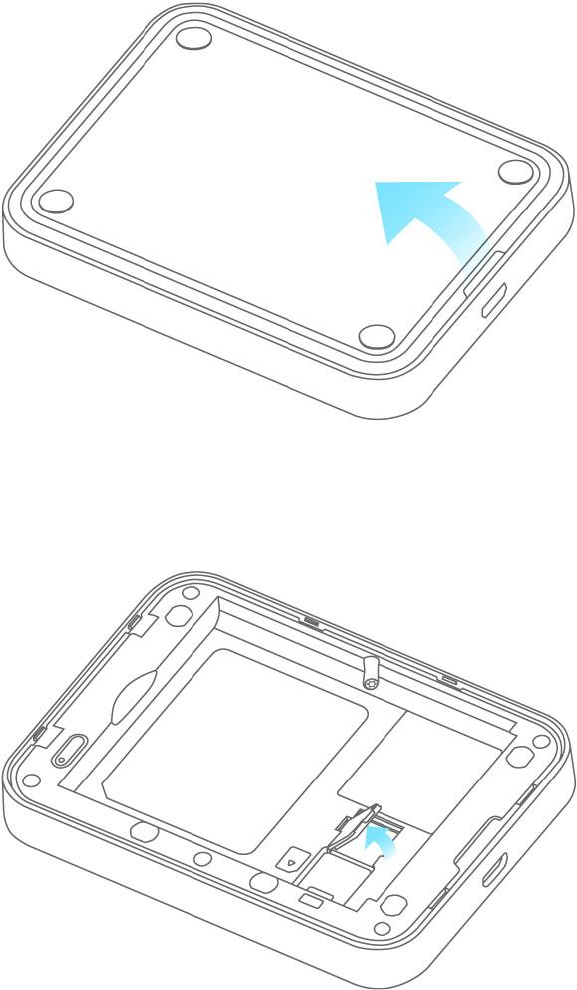
Index 11
Insert a SIM Card
Follow these instructions to insert a SIM card. Remember to power off your device before inserting a SIM
card.
Note: Your device's SIM card is preinstalled. These instructions are for reference only.
1. Remove the battery cover.
2. Remove the battery.
3. Open the SIM card cover.
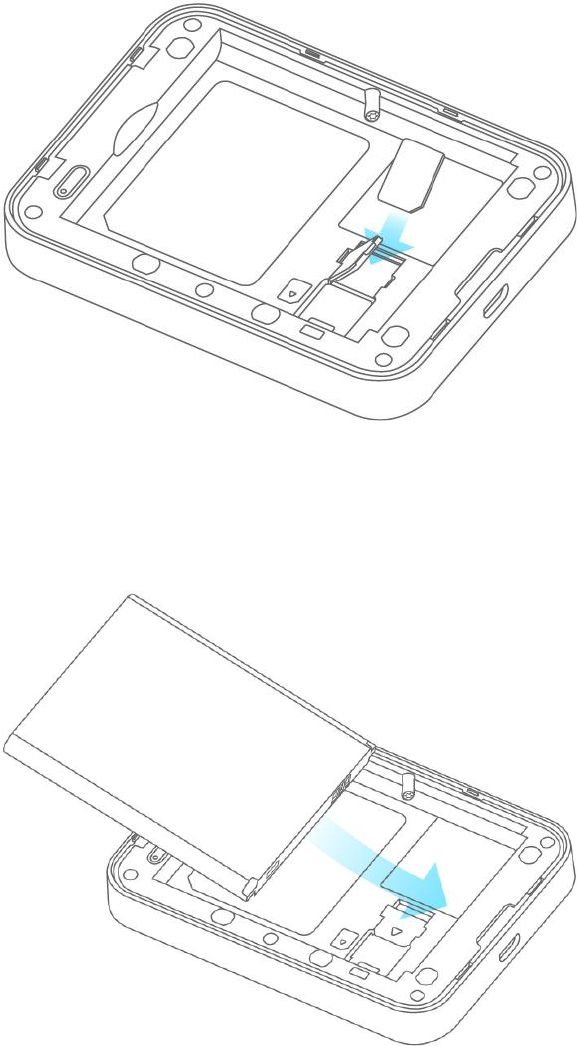
Index 12
4. Insert the SIM card.
Insert gently with gold IC chip facing downward.
5. Close the SIM card cover.
6. Insert the battery.
Align the contacts of the battery with the contacts in the device.
7. Attach the battery cover.
Remove the SIM Card
Follow these instructions to remove the device's SIM card.
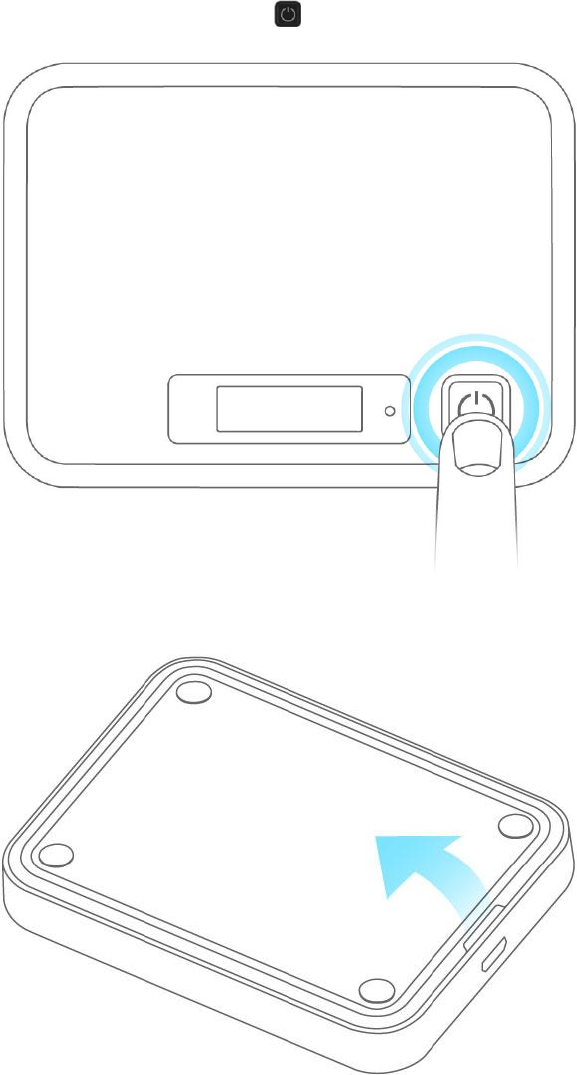
Index 13
1. Press and hold the Power key to turn off the device before removing the SIM card.
2. Remove the battery cover.
3. Remove the battery.
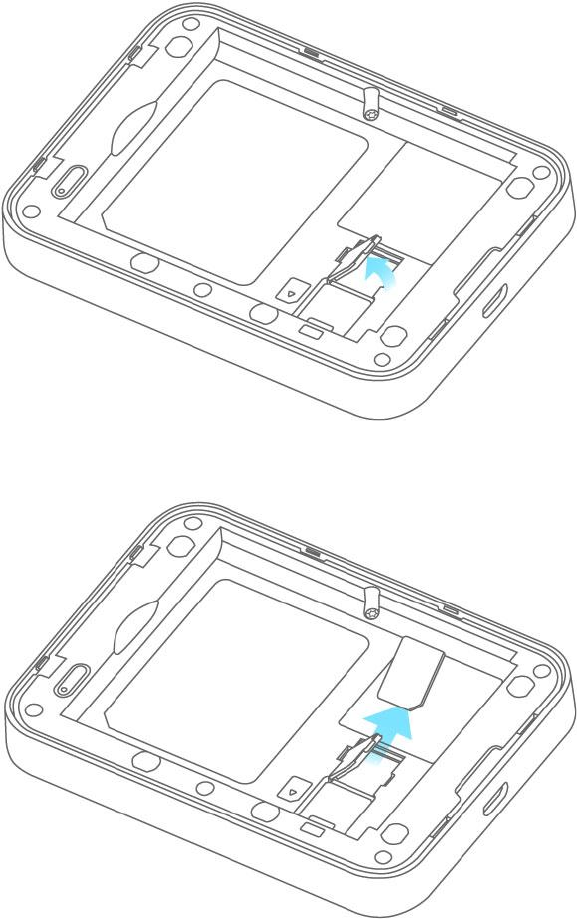
Index 14
4. Open the SIM card cover.
5. Remove the SIM card.
6. Close the SIM card cover.
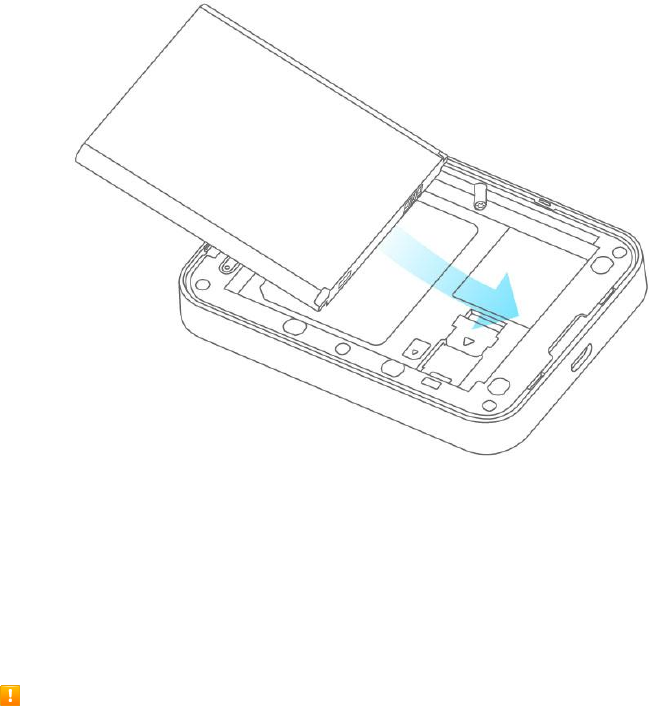
Index 15
7. Insert the battery.
Align the contacts of the battery with the contacts in the device.
8. Attach the battery cover.
Battery Use
The following topics explain how to insert and remove your device's battery.
Battery Cautions
Storage: Avoid storing or leaving the battery with no charge remaining. Saved information and
settings may become lost or changed, or battery may become unusable. Charge once every six
months before storing or leaving unused for a long period.
Bulges: Depending on use, bulges may appear near end of battery life. This does not affect safety.
Replacing the Battery: The battery is a consumable item. It needs to be replaced if operating time
shortens noticeably. Purchase a new battery.
Cleaning: Clean soiled terminals between battery and device with a clean, dry cotton swab. Soiled
terminals can result in a poor connection and prevent charging, etc.
Insert the Battery
Follow these instructions to insert your device's battery safely and properly. Make sure the device is
turned off before
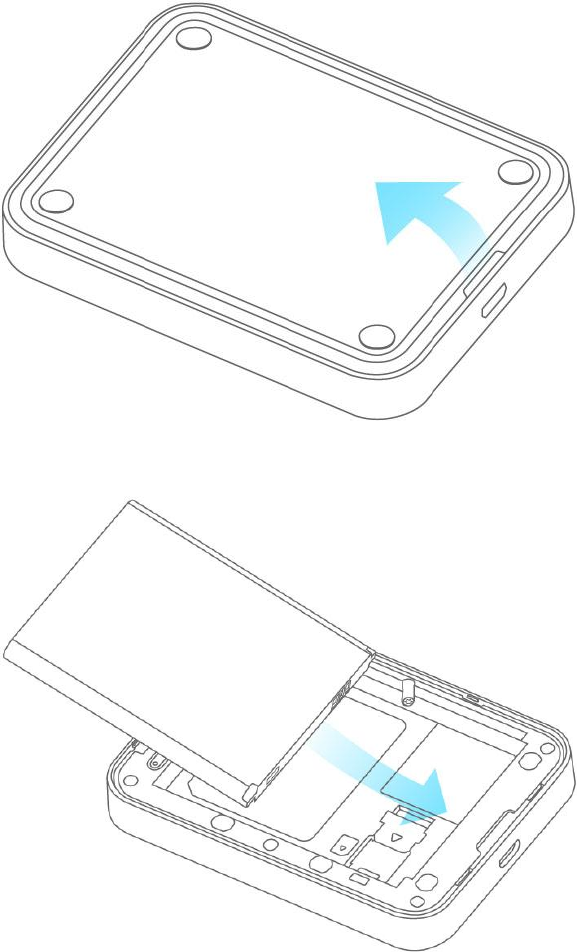
Index 16
1. Remove the battery cover.
2. Insert the battery.
Align the contacts of the battery with the contacts in the device.
3. Replace the battery cover.
Remove the Battery
Follow these instructions to remove your device's battery. Always power the device off before removing
the battery.
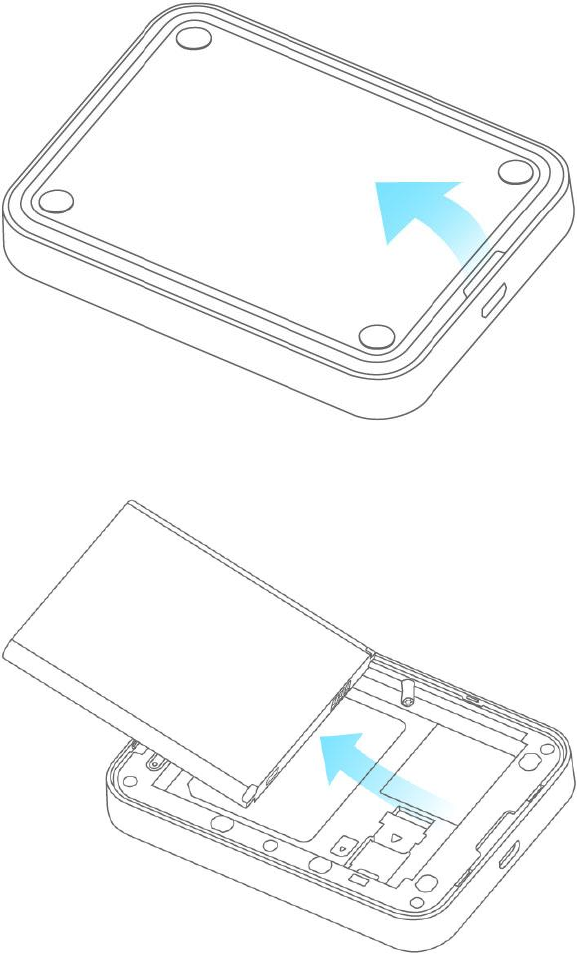
Index 17
1. Remove the battery cover.
2. Remove the battery.
3. Replace the battery cover
Charge the Battery
Follow these instructions to charge your device's battery using either the included AC adapter or via a
USB connection on your computer.
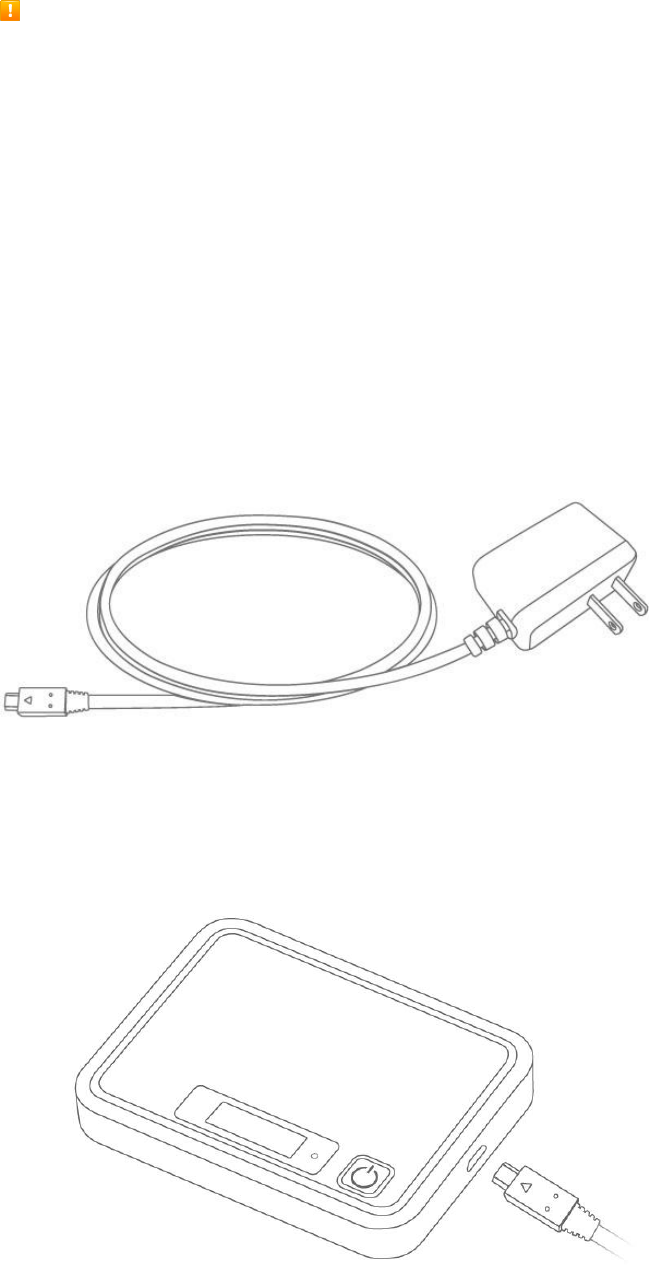
Index 18
Battery Charging Cautions
Charging Conditions: Under low temperatures charging performance decreases. Charge in
temperatures between 5°C – 35°C. Do not charge in places where there is high humidity. USB
charging may be unavailable depending on Wi-Fi router temperature.
Use Supplied Accessories: Always use the supplied AC adapter or micro USB cable.
Precaution for Extended Use: Your device may become hot when used for a long time or while
charging, especially in high temperatures. Prolonged contact with skin may cause low-temperature
burn injuries.
The R850 and AC Adapter Becoming Warm or Hot: Your device and the AC adapter may become
warm while charging. This is not a malfunction. However, stop using them immediately if they become
extremely hot; this could indicate a malfunction.
Charge Using the AC Adapter
Use the supplied AC adapter.
1. Plug the AC adapter into an electrical outlet.
The indicator light illuminates when charging starts. The light turns green when the battery is
fully charged. Fully charging a battery may take up to three hours.
2. After charging, disconnect the device from the charger.
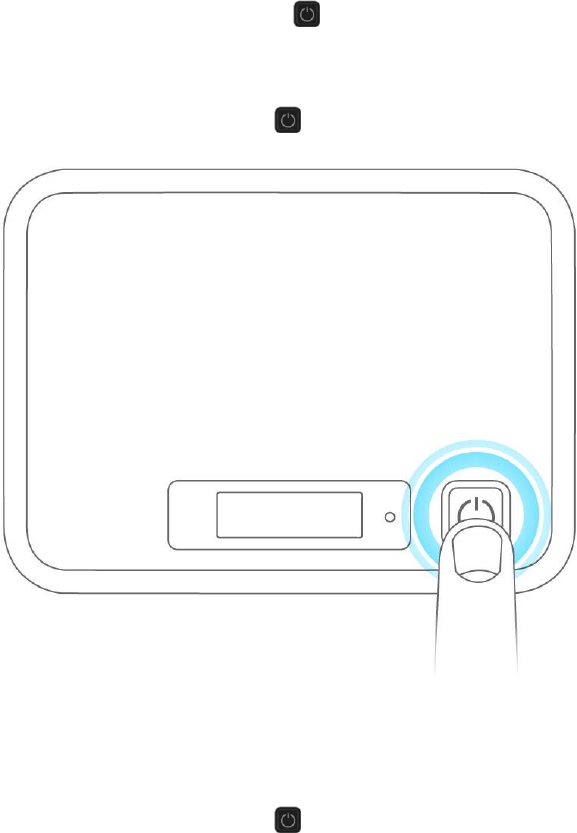
Index 19
Unplug the AC adapter from the outlet, and remove the AC adapter from the device.
Turn Your Device On and Off
The instructions below explain how to turn your device on and off, or to restart your device if it cannot be
powered on and off using the Power key .
Turn Your Device On
■ Press and hold the Power key .
Your device's Wi-Fi function activates and automatically connects to the Internet.
Turn Your Device Off
■ Press and hold the Power key .
Your device will power off.
Your screen remains blank while your device is off.
Restart Your Device
If your device will not turn on or off using the Power key, use the action below to restart it.
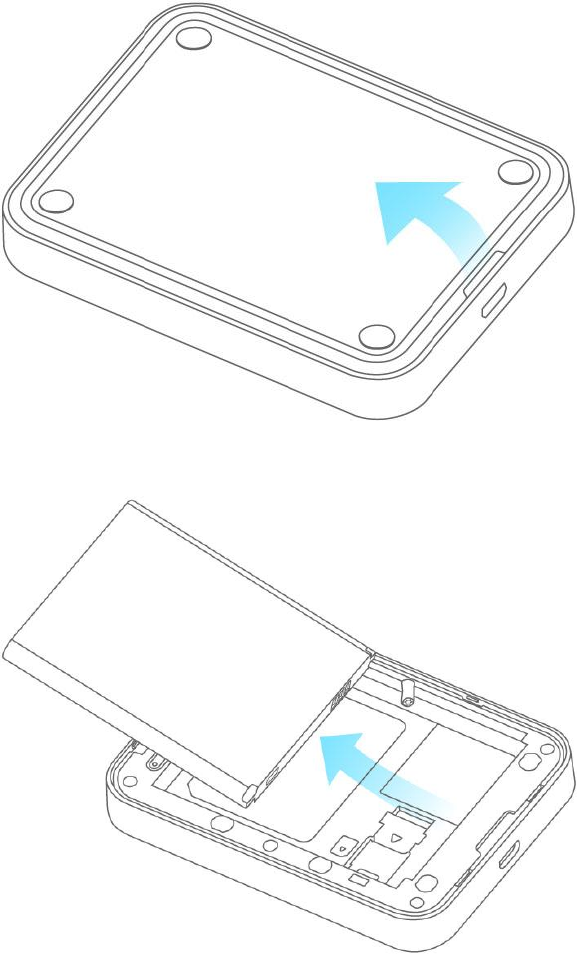
Index 20
1. Remove the battery cover.
2. Remove the battery.
3. Replace the battery cover
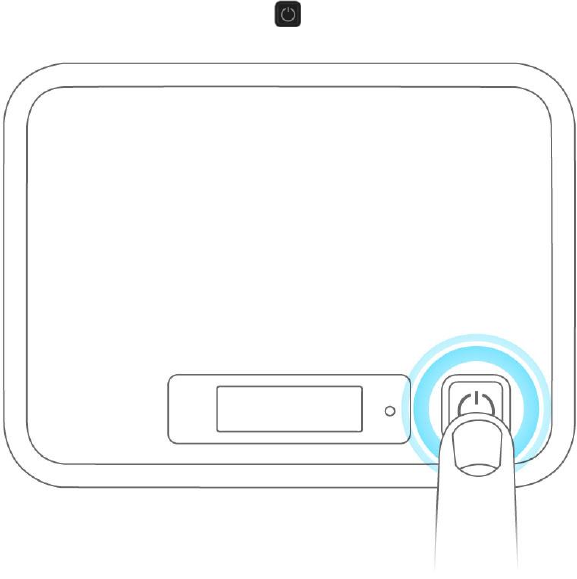
Index 21
4. Press and hold the Power key .
Note: Restarting your device does not reset the device settings.

Index 22
Connect with Wi-Fi (WLAN)
The following topics outline basic features and operations of your device's Wi-Fi (WLAN) connections,
including connecting with various OS and device types.
Wi-Fi (WLAN) Overview
Below are some basics of your device's Wi-Fi (WLAN) function.
Wi-Fi (WLAN) Information
● Advanced Settings: Change your devices Wi-Fi (WLAN) settings as required. See Wi-Fi
Advanced Settings
● Simultaneous Connection: Use your device to connect up to 10 Wi-Fi devices simultaneously.
When Internet Wi-Fi is active, connect up to 10 devices.
● Automatic Updates for Optimizing Wi-Fi Connection: When connected by Wi-Fi, connection
optimizing settings may be automatically received and updated.
Wi-Fi (WLAN) Usage Cautions
For added security, it is recommended that you change the default network name (SSID) and security
key (WPA) after setting up your device.
Wi-Fi (WLAN) Overview
● Your device supports IEEE 802.11 b/g/n standards. Connect Wi-Fi devices (PC, game console,
etc.) via Wi-Fi for wireless data transfers.
● Your device supports Wi-Fi Protected Setup (WPS), which allows Wi-Fi connection settings to be
easily configured on any WPS-compliant device.
● Enter Wi-Fi router's SSID and WPA keys to connect non-WPS-compliant Wi-Fi devices.
These settings should be performed when the device is connected the first time to another
Wi-Fi device. Thereafter, simply activate Wi-Fi (WLAN) to automatically connect your mobile
broadband device to the Wi-Fi (WLAN) device.
Activate Wi-Fi (WLAN) Function
Follow the instructions below to activate your device's Wi-Fi function and connect to the Internet via an
available 4G LTE connection. Your device searches for and makes a connection automatically upon
powering up. Use the Web UI to select a network.
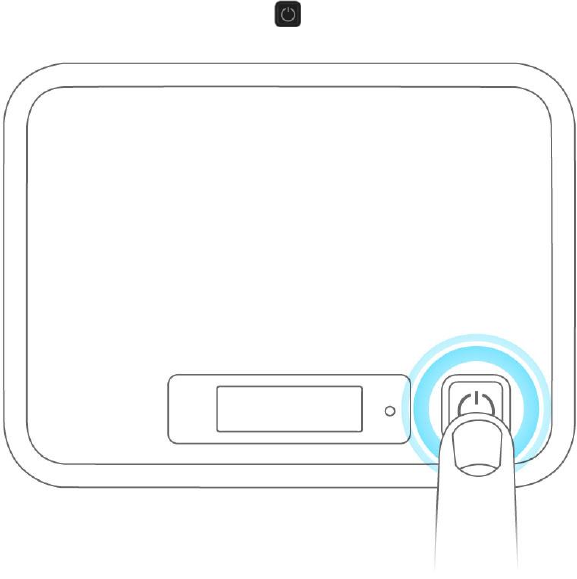
Index 23
■ Press and hold the Power key .
Your device's Wi-Fi function activates and automatically connects to the Internet.
Connect Windows PCs with Wi-Fi
The following topics describe how to connect your device with various versions of Windows PCs via Wi-Fi.
Windows 8
Connect Windows 8 PCs to your device with Wi-Fi.
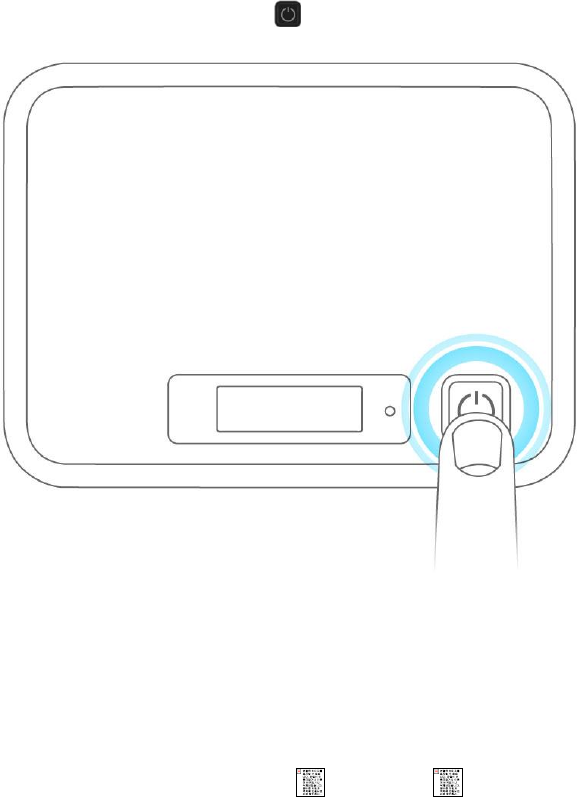
Index 24
1. Press and hold the Power key .
Your device's Wi-Fi function activates and automatically connects to the Internet.
2. Activate your PC's Wi-Fi function.
Consult your PC's operation manual for details on activating Wi-Fi.
3. On your PC, move the cursor to the upper-right or lower-right corner (or swipe from the right side
on a touchscreen PC) and select > Network .
[illustration]
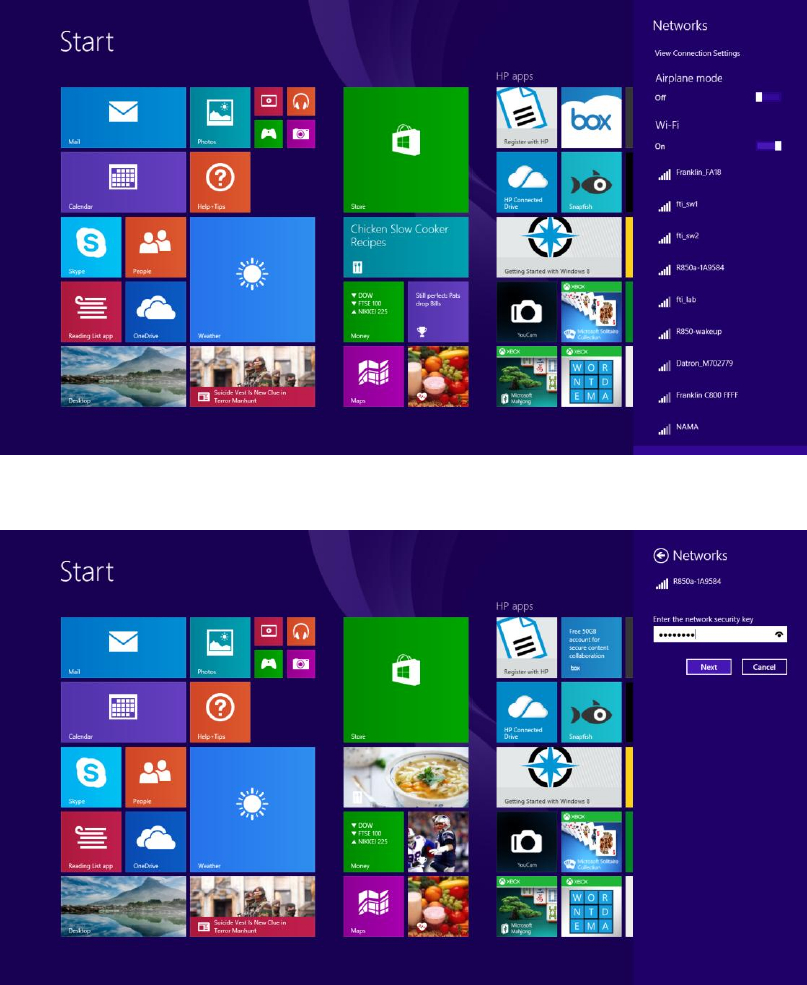
Index 25
4. Select your device's SSID from the list, and click Connect.
5. Enter the security key (WPA) and then click Next.
The PC connects to your device. The connected status icon on your device will show an
additional device has been connected.
Windows 7
Connect Windows 7 PCs to your device with Wi-Fi.
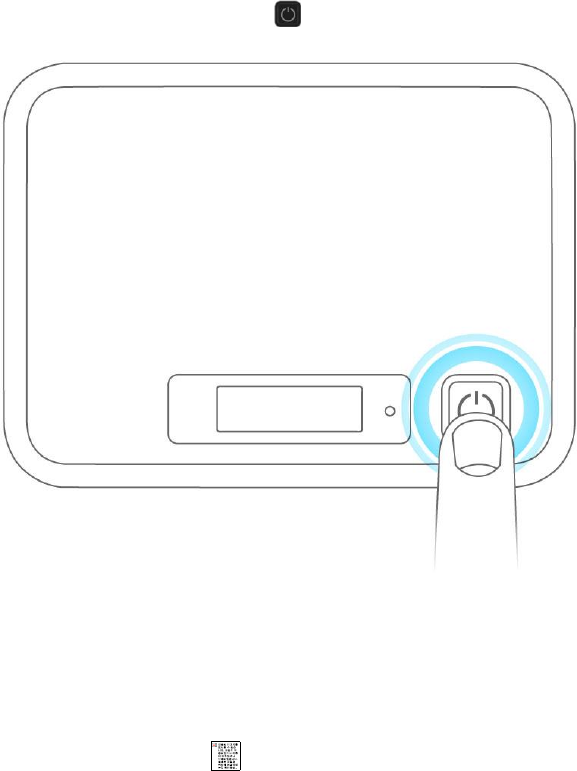
Index 26
1. Press and hold the Power key .
Your device's Wi-Fi function activates and automatically connects to the Internet.
2. Activate your PC's Wi-Fi function.
Consult your PC's operation manual for details on activating Wi-Fi.
3. On your PC, click Start > Control Panel > Network and Internet > Network and Sharing
Center.
[illustration]
4. Click Connect to a network.
[illustration]
5. Select your device's SSID from the list, and click Connect.
[illustration]
6. Enter the security key (WPA) and then click OK.
[illustration]
The PC connects to your device. The connected status icon on your device will show an
additional device has been connected.
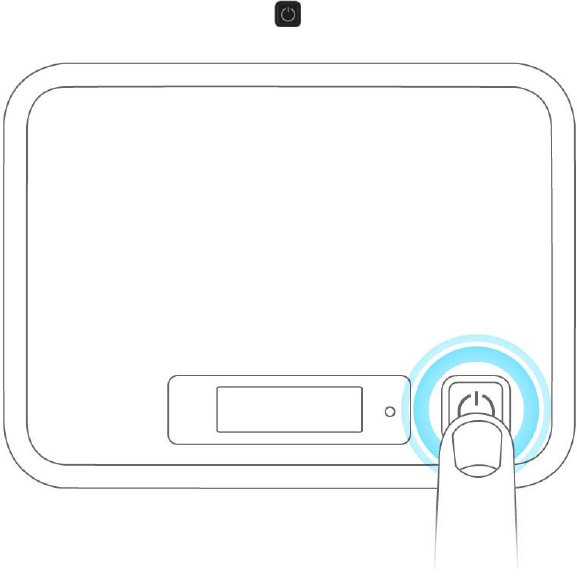
Index 27
Connect Mac Computers with Wi-Fi
Follow the instructions below to connect a Mac computer to your device via Wi-Fi.
Note: The operations depicted are based on Mac OS X 10.xx, with Wi-Fi security set to [xxx].
1. Press and hold the Power key .
Your device's Wi-Fi function activates and automatically connects to the Internet.
2. On your Mac, in the Apple menu, click System Preferences… > Network.
[illustration]
3. Click Wi-Fi > Turn Wi-Fi On.
[illustration]
Your computer's Wi-Fi function activates.
4. Select your device's SSID from the Network Name pulldown list.
[illustration]
5. Enter the security key (WPA) in the Password field, check Remember this network, and then
click Join.
[illustration]
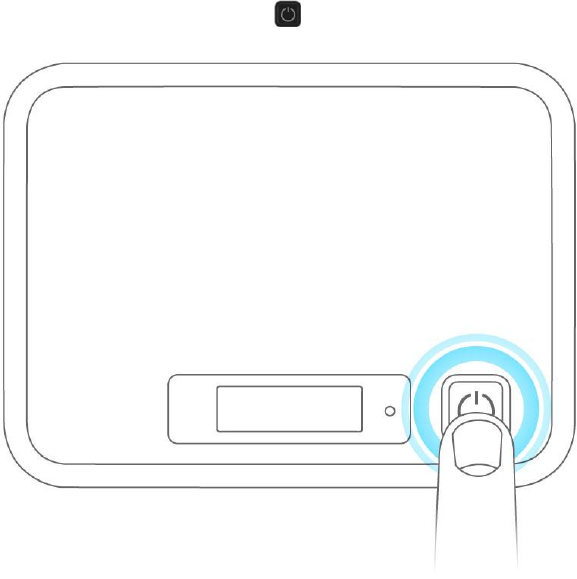
Index 28
The computer connects to your device. The connected status icon on your device will show an
additional device has been connected.
Connect iPhone/iPod Touch/iPad
The following topics outline how to connect your iPhone, iPod Touch, or iPad to your device via Wi-Fi.
Connect an iPhone or an iPod Touch
Follow the instructions to connect your iPhone or iPod Touch to your device using Wi-Fi.
Note: The operations below are based on your iPhone or iPod Touch Wi-Fi security set to [xxx].
1. Press and hold the Power key .
Your device's Wi-Fi function activates and automatically connects to the Internet.
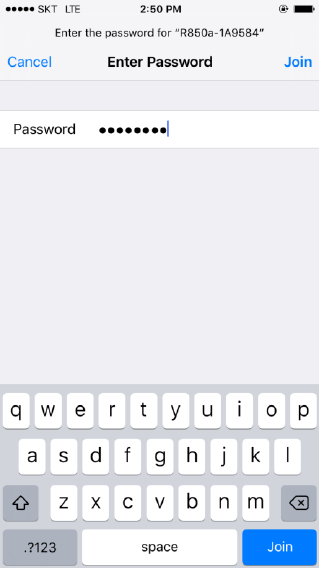
Index 31
5. Enter the security key (WPA) and then tap Join.
The iPhone or iPod Touch connects to your device. The connected status icon on your device
will show an additional device has been connected.
Connect an iPad
Follow the instruction to connect your iPad to your device using Wi-Fi.
Note: The operations below are based on your iPad Wi-Fi security set to [xxx].
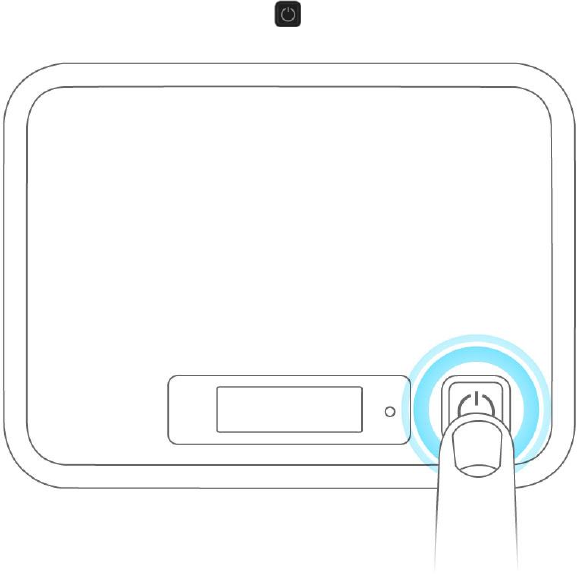
Index 35
Connect an Android™ Device
You can share your device's connection with compatible Android devices, such as wireless phones,
tablets, and Chromebook computers.
Note: The operations below are based on generic Android devices with Wi-Fi security set to [xxx].
Operation may vary depending on Android device type. See your Android device user guide for details.
1. Press and hold the Power key .
Your device's Wi-Fi function activates and automatically connects to the Internet.
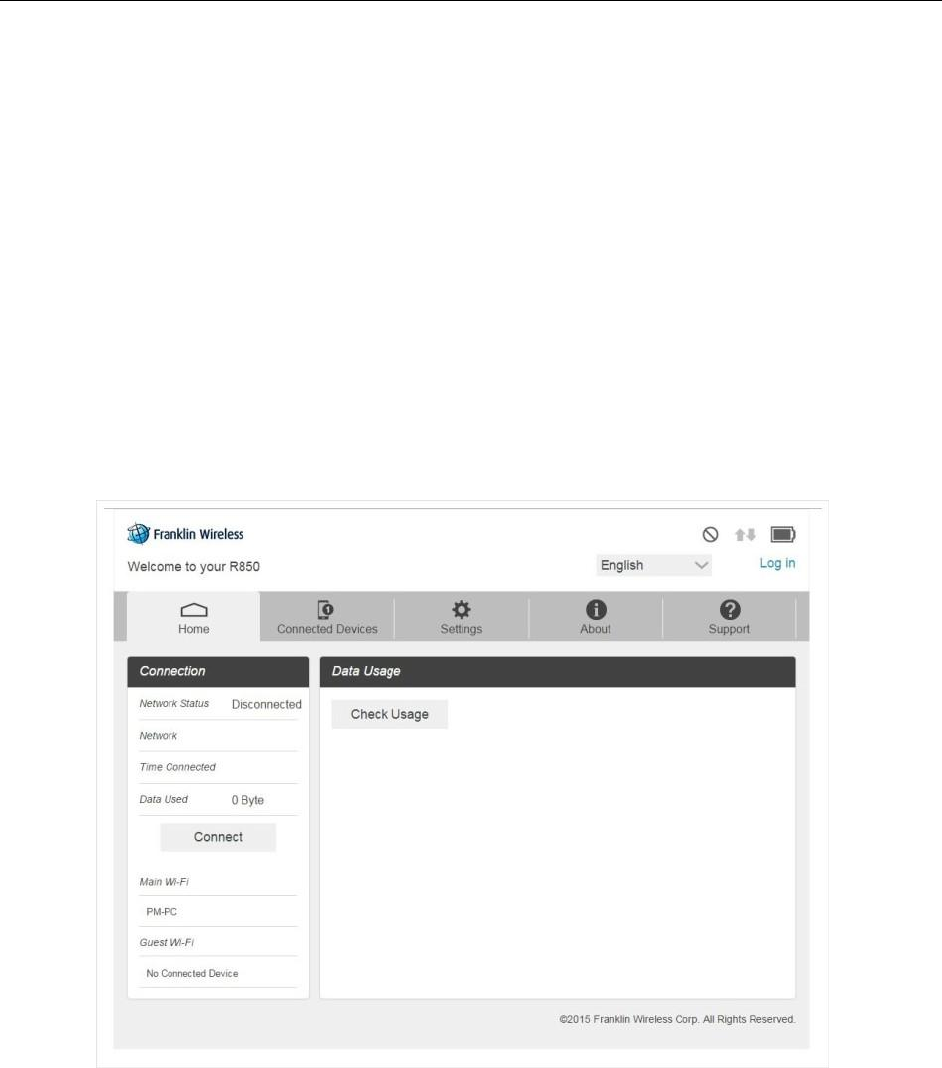
Index 39
Settings
The following topics provide an overview of items you can change using the device setting menu
accessed through the Web UI.
Web UI Overview
Use the device Web UI in a browser to check or change your mobile broadband device settings from a
device connected via Wi-Fi.
Web UI Window
Explore the options available through the device's Web UI window.
1. Connect your mobile broadband device to an external device via a Wi-Fi connection.
2. Launch a browser and access the Web UI via http://myhotspot or http://192.168.128.1 .
The Web UI launches and displays the main window.
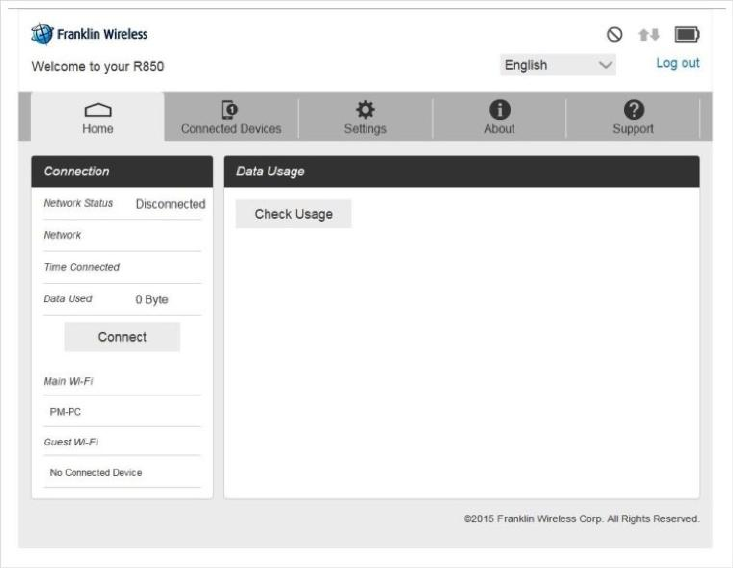
Index 40
Home
Check current status of network connection and data usage on the Home page.
■ From the Web UI, click the Home tab. (For connection information, see Web UI Overview.)
Connected Devices
The Connected Devices tab lets you confirm the names and MAC addresses of devices currently
connected to your device and set access permissions.
Check the Connected Devices
■ From the Web UI, click Connected Devices > Connected to display the list of connected
devices.
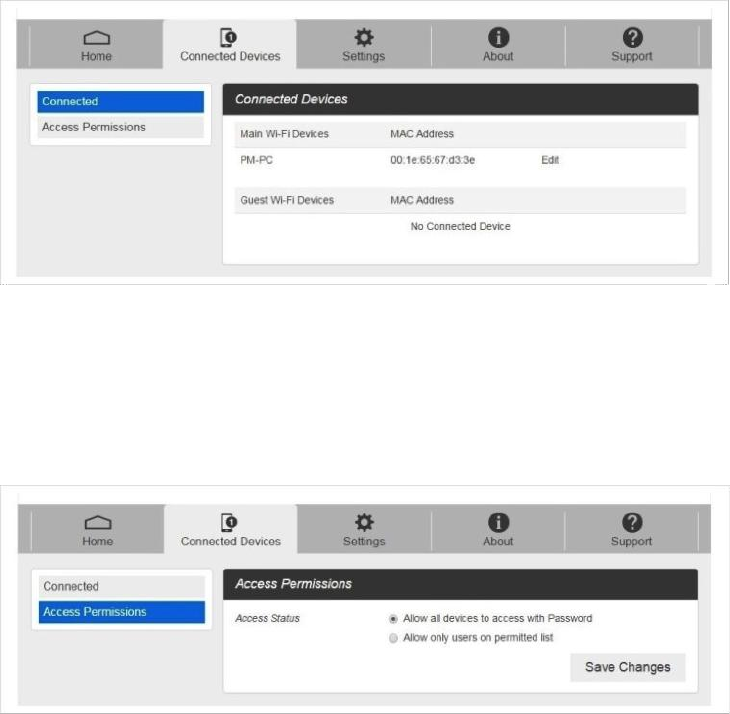
Index 41
Set Access Permissions
Control user's ability to access main or guest Wi-Fi. Changing this status will immediately update the
status of devices listed ability to access Wi-Fi from this device, even if they have the password.
1. From the Web UI, click Connected Devices > Access Permissions.
2. Select an access status and then click Save Changes.
Add Permitted Devices
The Access Permissions menu allows you to restrict access only to specific users, instead of anyone who
enters the password. To restrict access in this manner, you need to add permitted users from the menu.
1. From the Access Permissions menu, select Allow only users on Permitted list.
The Add Devices option will appear onscreen.
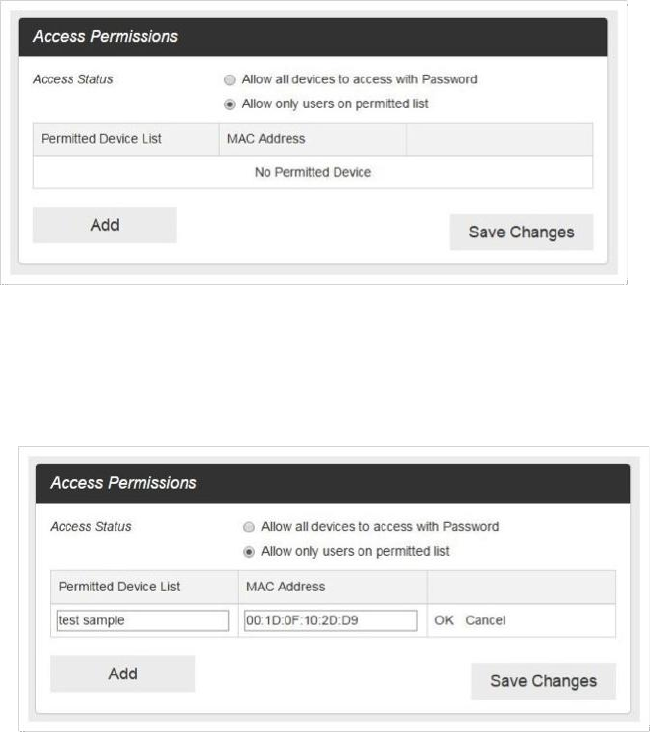
Index 42
2. Click > next to Add Devices to open the Add Devices menu, and then click Add More.
3. Enter a Friendly Name (optional) and the MAC address of the permitted device.
A sample MAC address might be 00:1D:0F:10:2D:D9.
4. Click Add More to add more permitted devices.
5. When you are finished adding permitted devices, click Save Changes.
Access to your device will be restricted to the devices in your list.
Settings Tab
Set your device options, including Wi-Fi, Mobile Network, Device and Advance Router.
Wi-Fi Basic Settings
Set the basic Wi-Fi settings for your device.
1. From the Web UI, click Settings > Wi-Fi > Basic to display the basic wireless network
parameters.
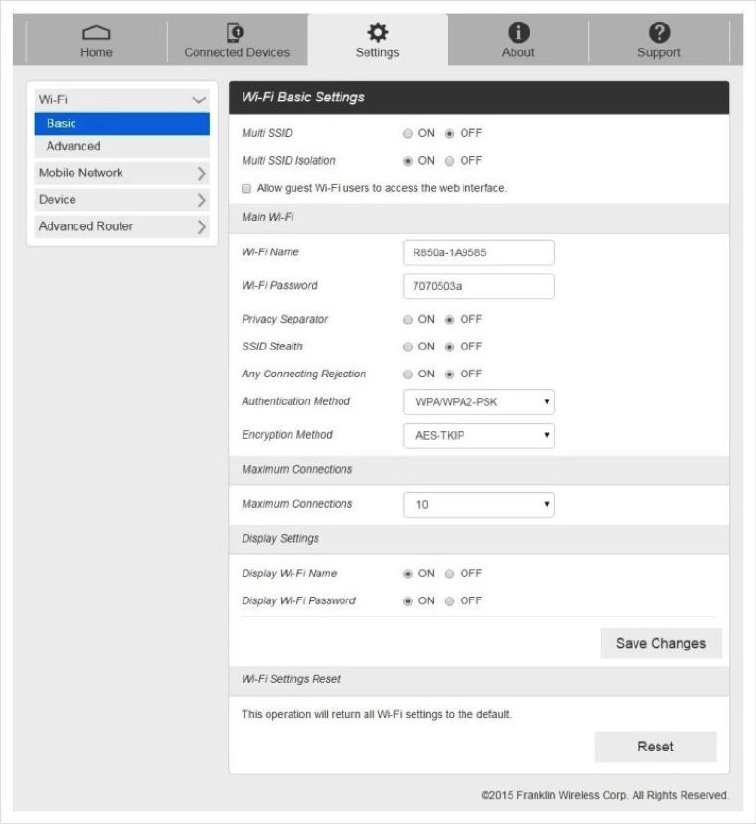
Index 43
Wi-Fi Broadcast Isolation: Enable or disable this function. If On is selected, it will prevents
your device from communicating across the different Wi-Fi's.
Wi-Fi Name: Service Set Identifier (SSID). Enter a string less than 32 characters as the
name for your wireless local area network (WLAN).
Wi-Fi Password: Enter the Wi-Fi password.
Display Wi-Fi Name: Enable or disable this function. If On is selected, your device's name
will be displayed on the device.
Display Wi-Fi Password: Enable or disable this function. If On is selected, your device's
password will be displayed on the device.
Hide SSID: Enable or disable this function. If Off is selected, your device's name will be
broadcast.
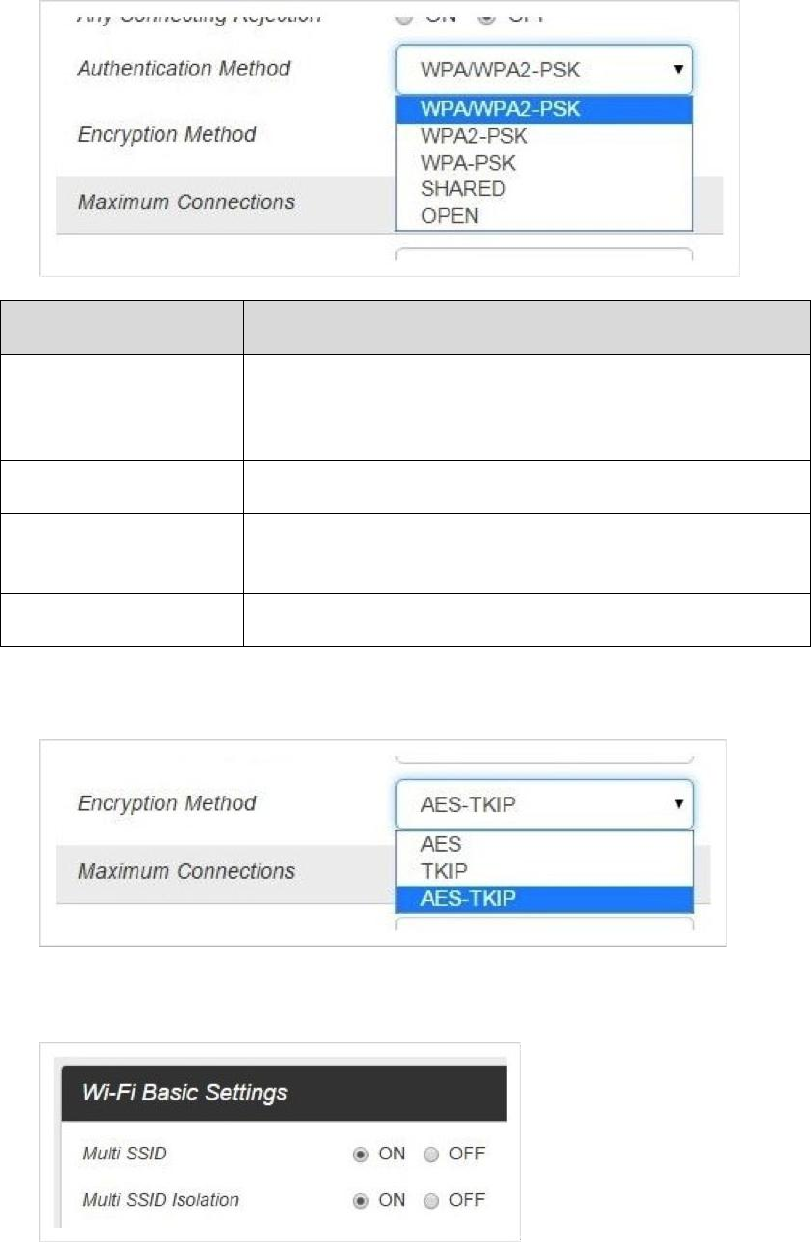
Index 44
Authentication Method: The authentication methods are described below.
Mode
Description
OPEN
Authentication and encryption won't be performed. There are
risks that private info will be intercepted or network will be
used by unauthorized individuals.
SHARED
Authentication via Shared Key protocol.
WPA2-PSK
WPA-PSK is the securer version of WPA with implementation
of the 802.11i standard.
WPA-PSK/WPA2-PSK
Apply both the WPA-PSK and WPA2-PSK scheme.
Encryption Method: Select an encryption method from the drop-down list.
Guest Mode: Enable or disable this function. If On is selected, the wireless devices
connected to your device will be unable to communicate with each other.
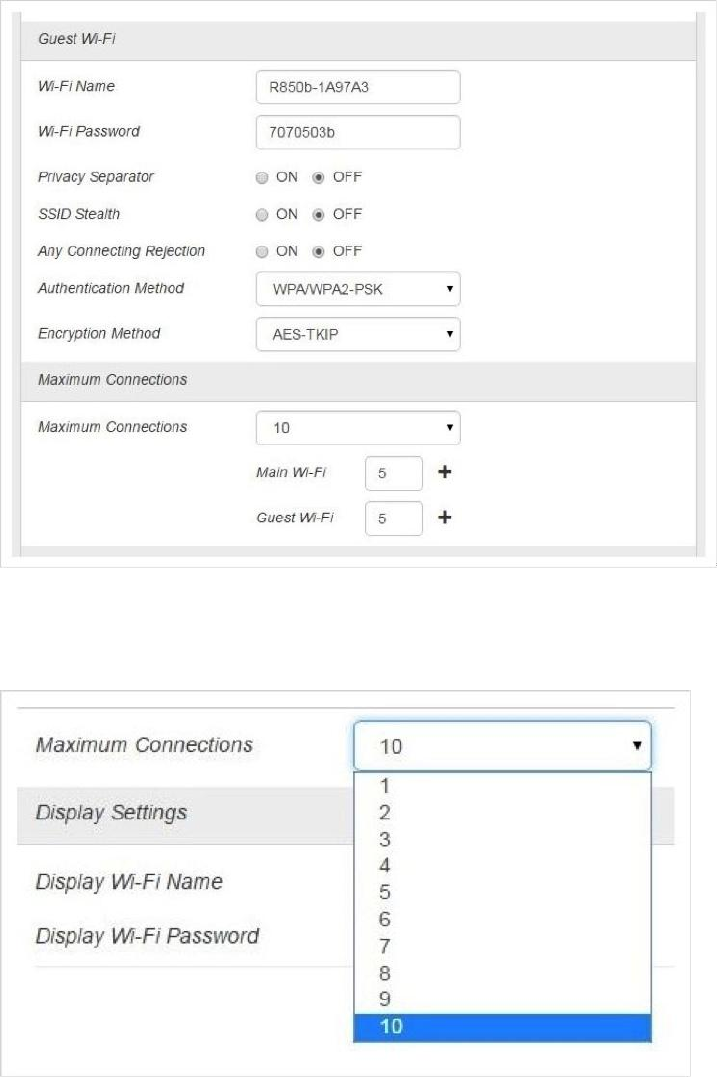
Index 45
Maximum Connections: Choose the maximum number of the devices which connect to your
device simultaneously. You can also click the right or left arrow to distribute the maximum
number of the connected devices between the Main Wi-Fi and the Guest Wi-Fi.
Wi-Fi Settings Reset: Click the Reset button to reset all Wi-Fi settings to the default.
2. Click Save Changes to save your settings.
Wi-Fi Advanced Settings
Configure your device's advanced Wi-Fi settings.
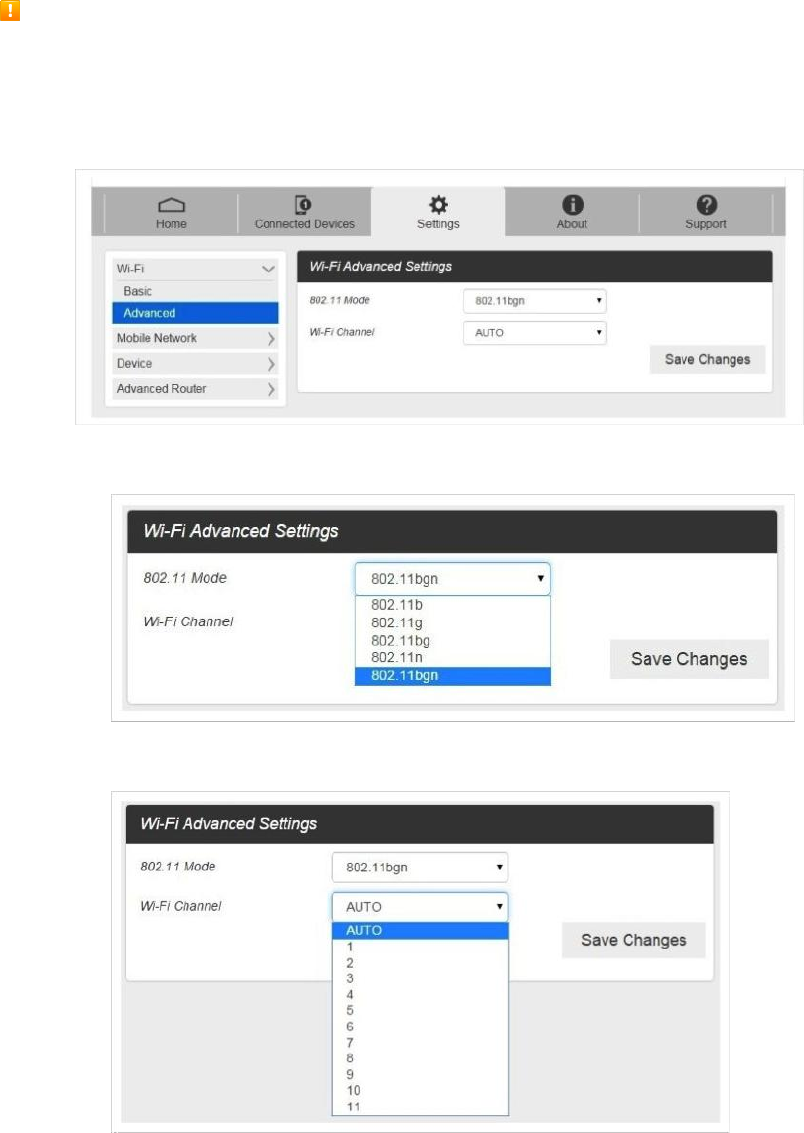
Index 46
Caution for Using Wi-Fi Advanced Settings
These advanced settings should only be changed for specific circumstances.
1. From the Web UI, click Settings > Wi-Fi > Advanced to view the wireless network advanced
parameters and the WPS settings shown in the following figure.
802.11 Mode: Select an 802.11 mode from the drop-down list.
Wi-Fi Channel: Select a Wi-Fi channel from the drop-down list.
2. Click Save Changes to save your settings.
Mobile Network Settings
Manage your mobile network settings.
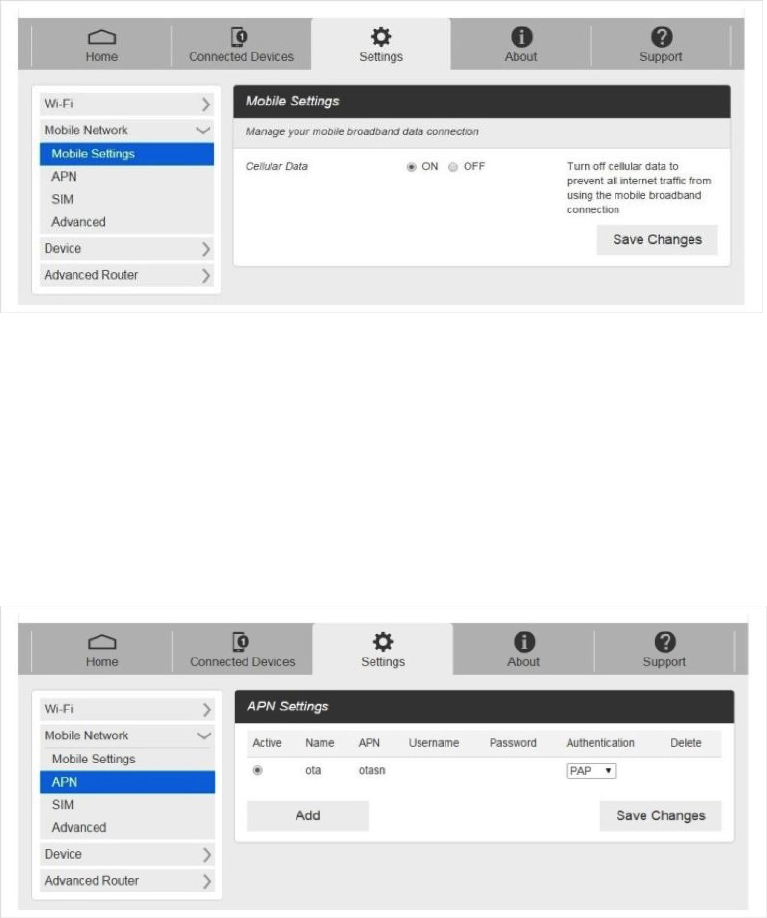
Index 47
Mobile Settings
1. From the Web UI, click Settings > Mobile Network > Mobile Settings. The Mobile Settings
page is shown in the following figure.
Cellular data: Turn Cellular data on or off. Turn it off to prevent all Internet traffic from using
the mobile broadband connection.
2. Click Save Changes to save your settings.
APN
■ From the Web UI, click Settings > Mobile Network > APN. The default APN parameters are
shown in the following figure. You can use the default APN to connect to the Internet. You can
also add new APNs.
To add a new APN, follow the steps below:
1. Click Add to access the following page.
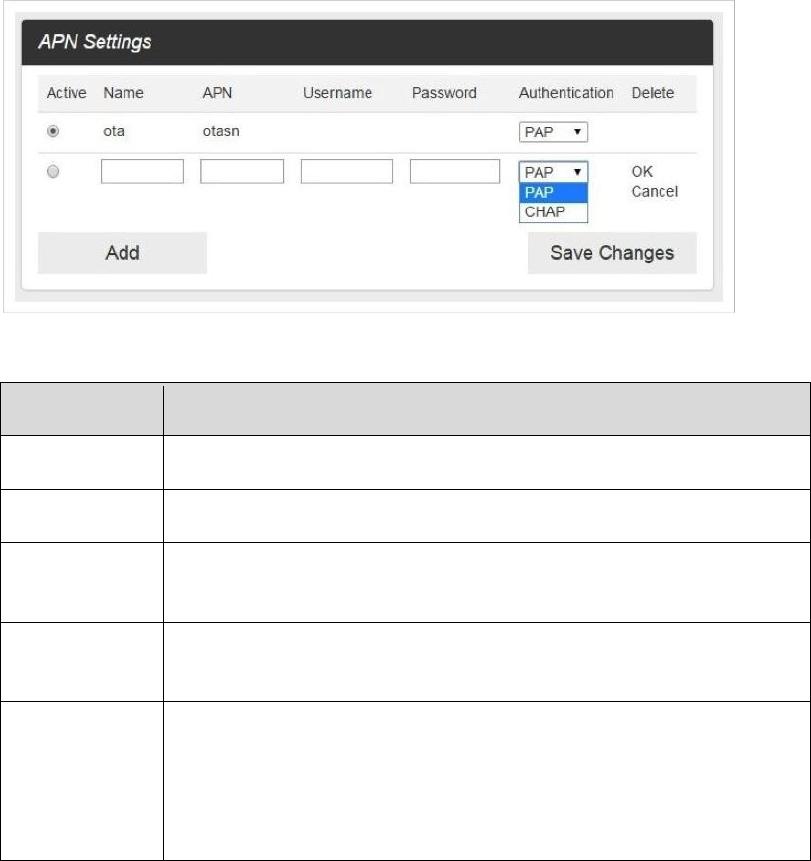
Index 48
2. Enter the related parameters as described in the following table.
Parameters
Description
Name
Type the profile name.
APN
Type the APN string.
User name
User name is used to obtain authentication from the ISP when the
connection is established.
Password
Password is used to obtain authentication from the ISP when the
connection is established.
Authentication
Password Authentication Protocol (PAP) provides a simple method
without encryption for the peer to establish its identity using a 2-way
handshake. Challenge-Handshake Authentication Protocol (CHAP) is
used to periodically verify the identity of the peer using a 3-way
handshake.
3. Click Save to add the new APN.
Additional APN Options
■ To activate the new APN, check the circle in front of it and then click Save Changes.
■ To edit the new APN, click Edit, change the settings, and then click Save.
■ To delete the new APN, click Delete.
Note: The default APN cannot be edited or deleted.
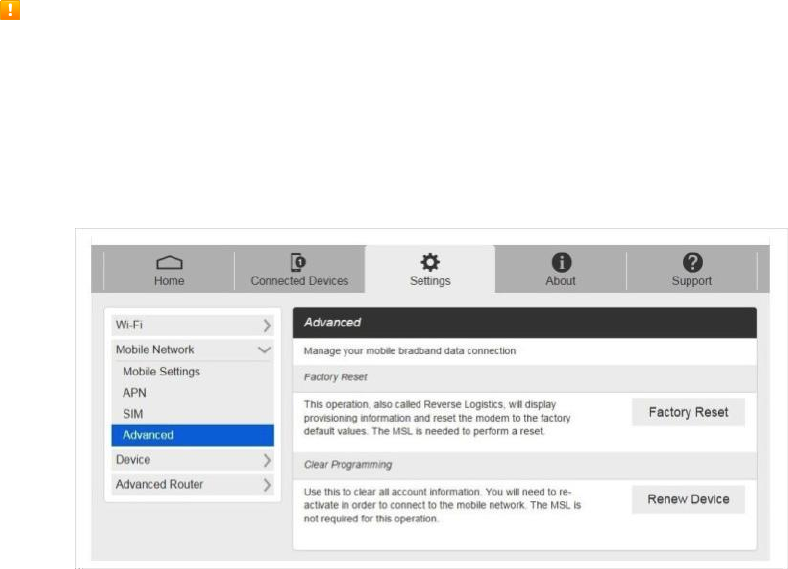
Index 49
Advanced Mobile Network Settings
Caution for Using Advanced Mobile Network Settings
Advanced Mobile Network Settings should only be used as directed by Sprint Customer Service
personnel. Certain advanced options will reset your device's connections and programming and will
require reactivation.
■ From the Web UI, click Settings > Mobile Network > Advanced to set the mobile network
advanced settings on this interface.
Factory Reset: Click Factory Reset to reset the modem to the factory default value.
Clear Programming: Click Renew Device to clear all account information.
Device Settings
The Device settings menu lets you set display brightness, manage account password, update software,
back up, restore and check system log.
Preferences
1. From the Web UI, click Settings > Device > Preferences. You can set the display timeout on
this page.
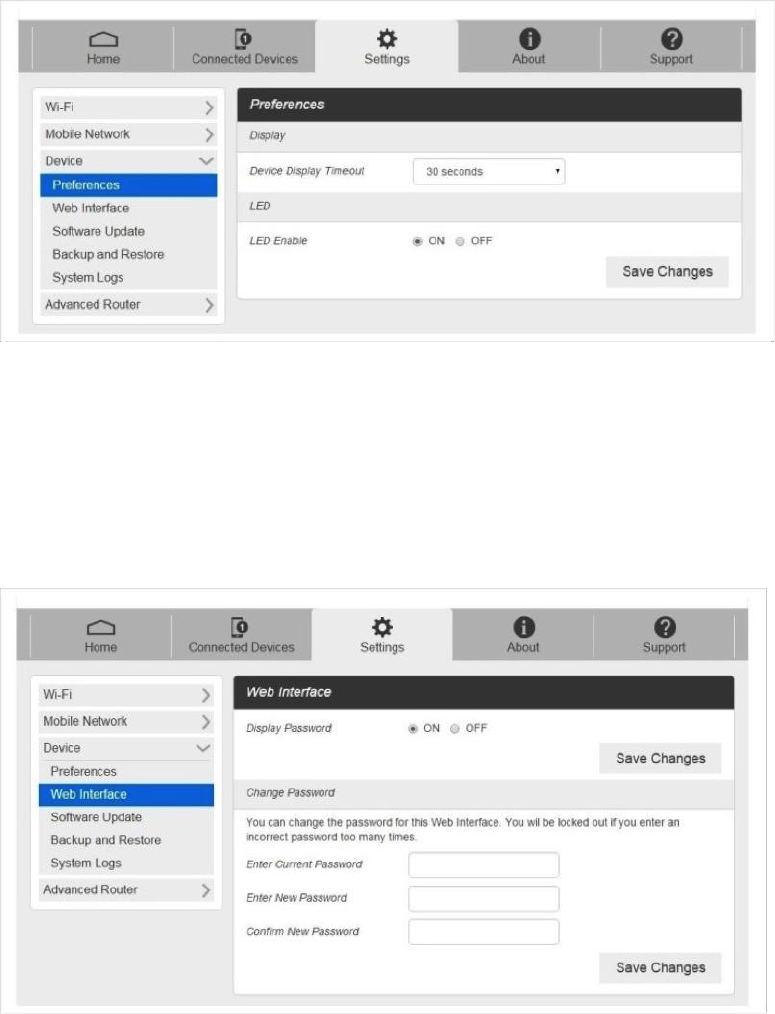
Index 50
Display Timeout: Select a timeout time from the drop-down list.
2. Click Save Changes to save your settings.
Web Interface
1. From the Web UI, click Settings > Device > Web Interface. You can manage your account
password on this page.
Current Password: Enter the current password.
New Password: Enter the new password.
Confirm New Password: Enter the new password again.
2. Click Save Changes to save your settings.
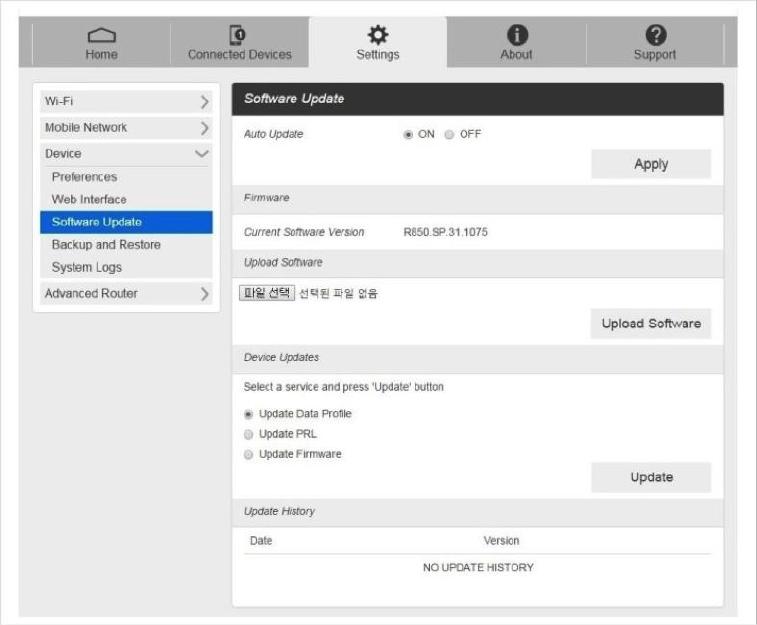
Index 51
Software Update
1. From the Web UI, click Settings > Device > Software Update. You can update the software on
this page.
2. Read the onscreen options and click the update you would like to initiate. For example, to update
your device's firmware (software version), click Update Firmware.
Back up and Restore
■ From the Web UI, click Settings > Device > Back up and Restore to access menus to back up
your device settings to your computer, restore from the backup and restore your device to its
factory default settings.
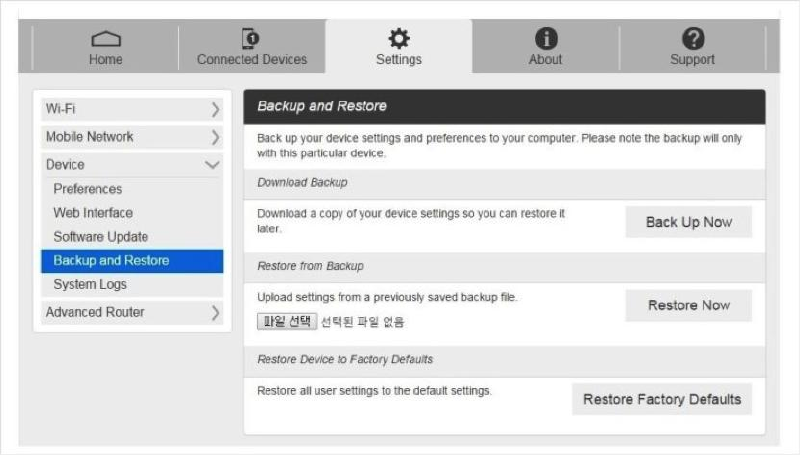
Index 52
To back up your device settings to your computer, follow the steps below:
1. Click Back up now.
2. Click Save on the pop-up window.
3. Choose a location on your computer to save the backup file.
4. Click Save.
To restore from the backup, follow the steps below:
1. Click Select File to select the backup file in your computer.
2. Click Restore now.
To restore your device to its factory default settings, follow the steps below:
1. Click Restore factory default.
2. Click Yes to confirm the command.
System Logs
■ From the Web UI, click Settings > Device > System logs, and then click Download logs to
download the system logs on this page.
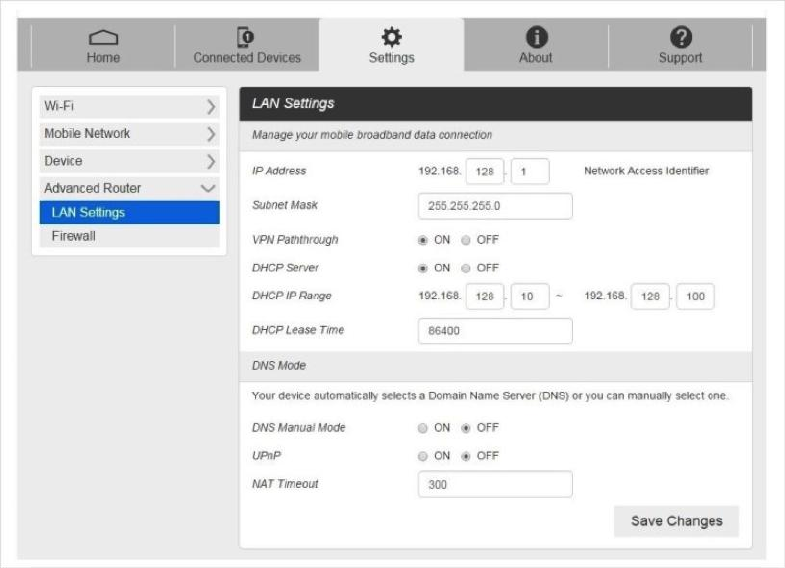
Index 54
IP Address: IP address for LAN interface.
Subnet Mask: Subnet mask for the IP address.
VPN passthrough: VPN passthrough must be enabled if you want to allow VPN tunnels to
pass through your device’s firewall.
DHCP Server: Enable or disable DHCP Server function.
DHCP IP Range: Allocate begin and end IP address for IP Range.
DHCP Lease Time: Define how long the leased IP address will be expired. The new IP
address will be relocated after the IP address is expired.
DNS manual mode: Turn DNS manual mode on or off.
NAT Timer: Set TCP NAT time.
2. Click Save Changes to save your settings.
Firewall
■ From the Web UI, click Settings > Advanced Router > Firewall. You may set up firewall rules to
protect your network from virus and malicious activity on the Internet.
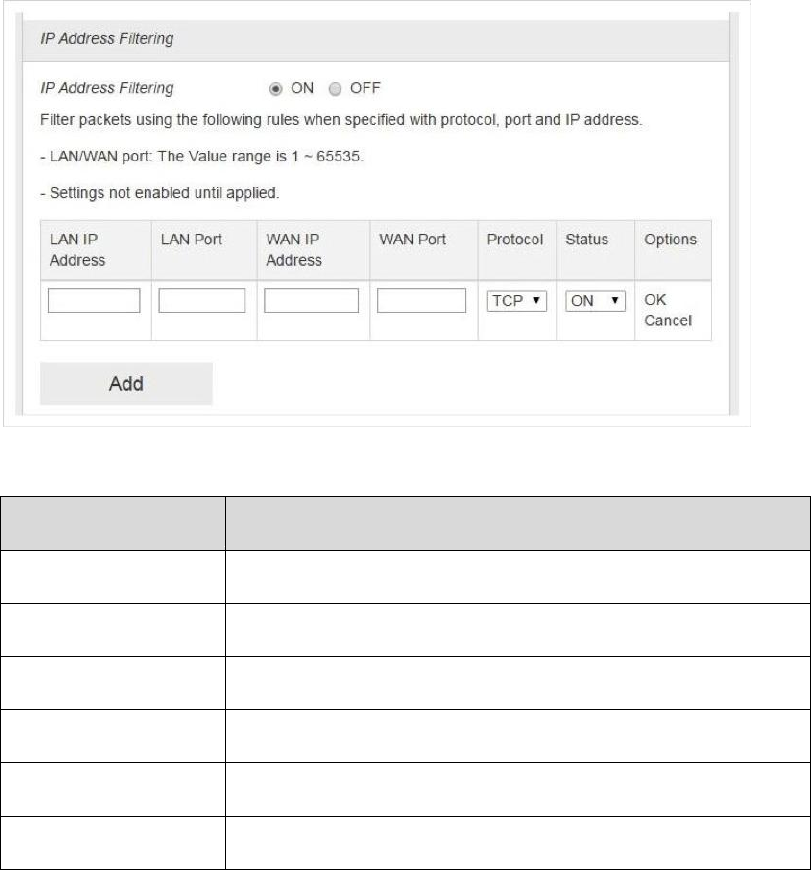
Index 56
2. Click Add.
3. Enter the related parameters as described in the following table.
Parameters
Description
LAN IP address
Enter the LAN IP address.
LAN port
Set the LAN port.
WAN IP address
Enter the WAN IP address.
WAN port
Set the WAN port.
Protocol
Set which protocol will be used for filtering.
Status
Set how to handle the packet if it matches with the rule.
4. Click Save Changes to add the new filtering rule.
Portmapping
To set portmapping rules, follow the steps below:
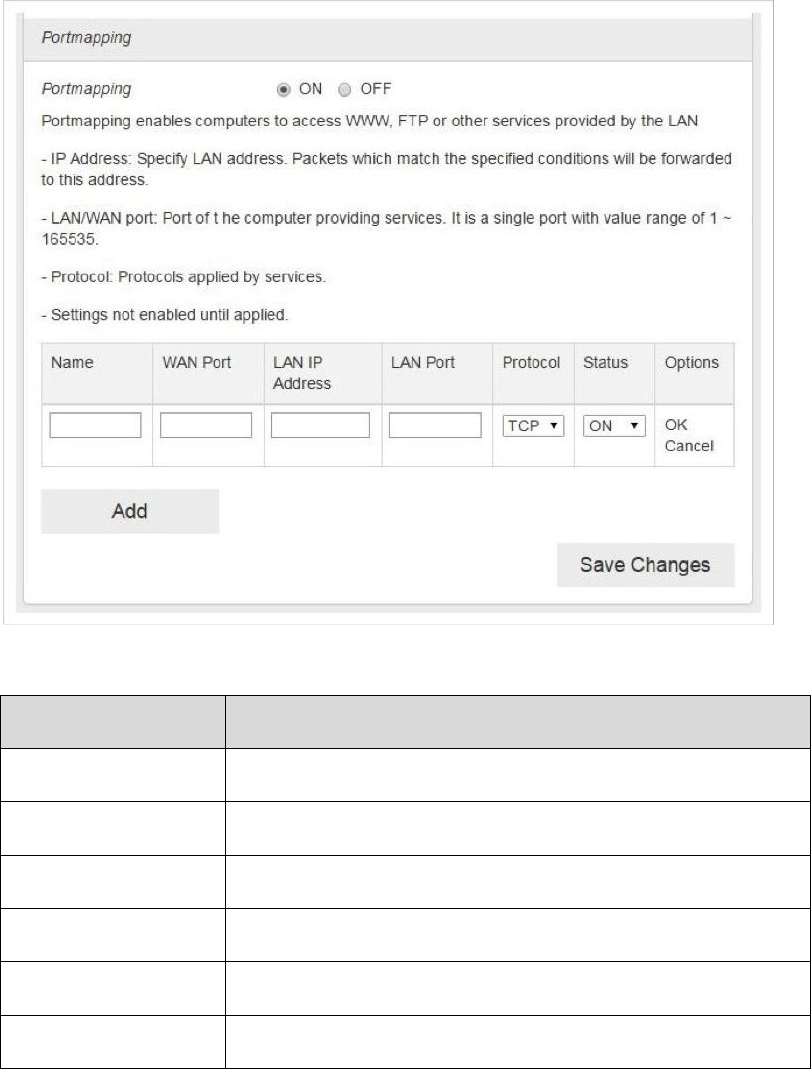
Index 58
2. Click Add.
3. Enter the related parameters as described in the following table.
Parameters
Description
Name
Enter a name for the rule.
WAN port
Set the WAN port.
LAN IP address
Enter the LAN IP address.
LAN port
Set the LAN port.
Protocol
Set which protocol will be used for filtering.
Status
Set how to handle the packet if it matches with the rule.
4. Click Save Changes to add the new portmapping rule.
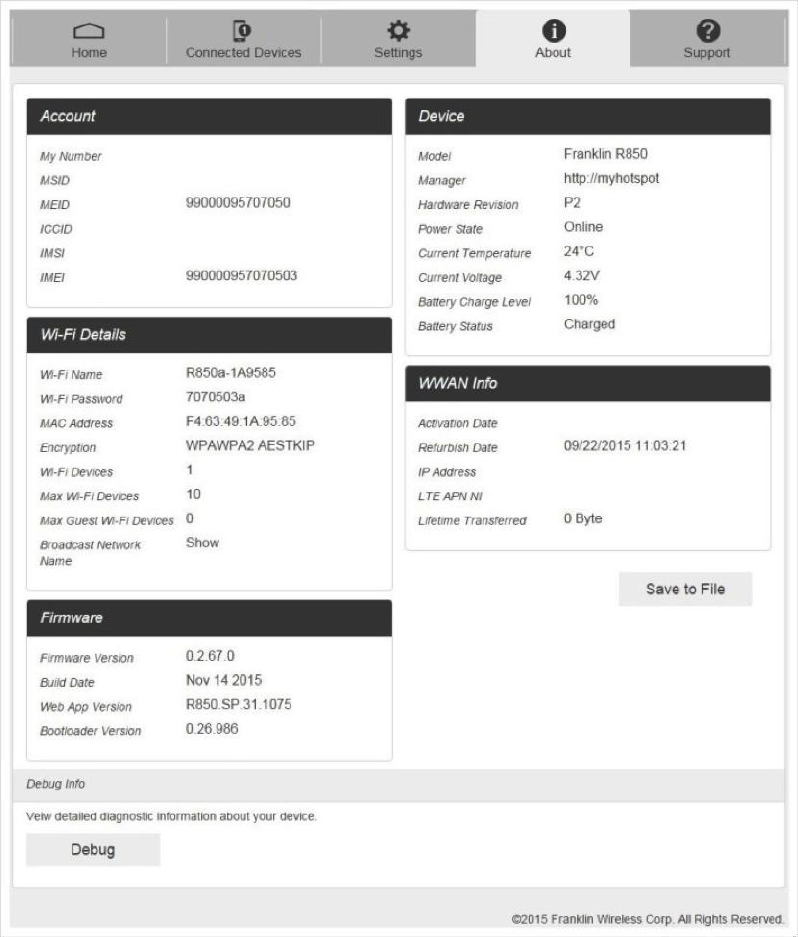
Index 59
About
Show your device's connection information, firmware information, WWAN information, Wi-Fi details and
device information.
1. Launch the Web UI on your connected device. See Web UI Overview for details.
2. Click the About tab to view the available information.
Note: You can also save this information to your computer by clicking Save to file.

Index 61
Appendix
The following topics cover items such as troubleshooting, device specifications, applicable warranty and
service information, customer service contacts, and applicable trademark and copyright notices.
Troubleshooting
Check the questions and answers below for troubleshooting solutions for common device issues.
Check Here First
Question: Unable to connect via Wi-Fi (WLAN)
Answer 1: Check whether the mobile broadband device is properly connected to the computer or
other external device.
Answer 2: If OPEN WEP is the security method being used, check whether the correct WEP key is
entered. If the WEP key is unknown, see Wi-Fi basic settings to reset the WEP key and reconnect the
device.
Answer 3: Check whether the correct WPA key is set. If the WPA key is unknown, see Wi-Fi basic
settings to reset the mobile broadband device or see the WLAN Initialization Sticker to reset the WPA
key, and then reconnect the device. WPA/WPA2 security may not be supported depending on the Wi-
Fi device. See the Wi-Fi device user guide for information.
Question: Internet connection fails.
Answer 1: Make sure that you are within the service area.
Answer 2: If signal reception is poor, move to where signal reception is good and then reconnect.
Answer 3: The access point might be busy depending on the time of day. Wait a little and then
reconnect.
Answer 4: Activate the Web UI and make sure that network settings are correct.
Question: Forgot PIN / Unknown PIN Unblocking Key (PUK) / SIM card is locked.
Answer: Contact Customer Service.
Question: SIM card is not recognized.
Answer 1: Check whether the SIM card is properly installed. For details, see Insert a SIM Card.
Answer 2: Check the SIM card for damage.
Answer 3: Check the SIM card IC chip for scratches/corrosion.
Answer 4: Dirty SIM card (particularly IC chip) may prevent recognition. Clean gently with a soft cloth.
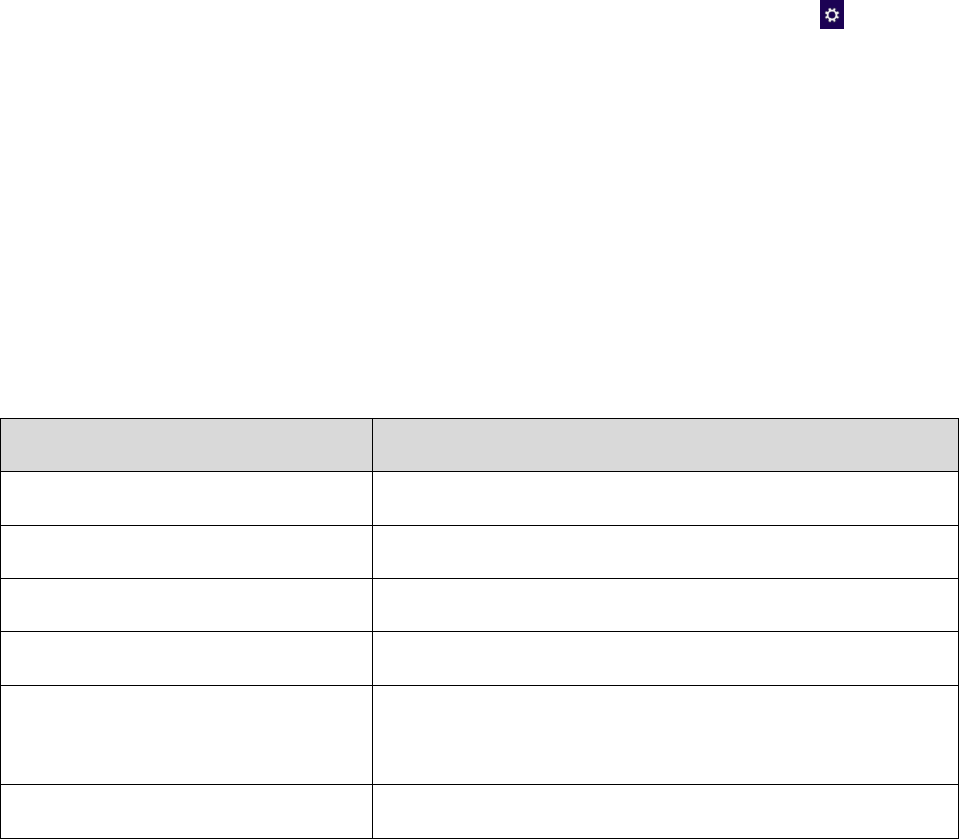
Index 62
Answer 5: Contact Customer Service.
Question: Unsure if logged on as an Administrator.
Answer 1: For Windows 8, follow these steps to check.
Move the pointer into the upper-right or lower-right corner and then click or tap > Control
Panel. Click Change your account type in User Accounts, and then check that the type of
account currently logged on to is "Administrator".
Answer 2: For Windows 7, check by following these steps.
Click Start menu > Control Panel > User Account and Family Safety > User Account,
and then check that the type of account currently logged on to is "Administrator".
Specifications
The following tables list the specifications for the mobile broadband device, the AC charger, the micro
USB cable, and the materials.
Device Specifications
Item
Description
Model name
R850 Mobile Hotspot
Dimensions1
12.5mm (H) x 90.1mm (W) x 67mm (D)
Weight
97g
Interface
Web UI
Power consumption
Normal state: 1.26 Watts
Max state : 2.52 Watts
Operating system
Linux OS

Index 63
Item
Description
Frequency
LTE B2
DL: 1930 ~ 1990 MHz UL: 1850 ~ 1910 MHz
LTE B4
DL: 2110 ~ 2155 MHz UL: 1710 ~ 1755 MHz
LTE B5
DL: 869 ~ 894 MHz UL: 824 ~ 849 MHz
LTE B12
DL: 729 ~ 746 MHz UL: 699 ~ 716 MHz
LTE B25
DL: 1930 ~ 1995 MHz UL: 1850 ~ 1915 MHz
LTE B26
DL: 859 ~ 894 MHz UL: 814 ~ 849 MHz
LTE B41
DL: 2496 ~ 2690 MHz UL: 2496 ~ 2690 MHz
WIFI(B/G/N)
2412MHz ~ 2462MHz
Compatible networks
LTE category 4 / Wi-Fi IEEE802.11 b/g/n
Charging time2
3 hours 40 minute
Continuous standby time3
41 hours
Continuous communication time3
8 hours
Communication speed
LTE category 4
DL : 150Mbps
UP : 50Mbps
1 Approximate values
2 Varies by ambient temperature, battery usage, etc.

Index 64
3 Varies by environment, signal conditions, etc.
AC Charger Specifications
Item
Description
Rated input voltage
100-240Vac
Operating range
90-264Vac
Rated input frequency
50/60Hz +/- 3Hz
Nominal dc output voltage
+5.0V (±5%)
Rating load current
1.0A
Materials Specifications
Parts
Materials/Finishing
A cover
PC(Black),SF coating
B cover
PC(Black)
Battery cover
PC(Black),SF coating
A deco
PC(Black),UV(Gloss 80%)
Power key
PC(Milky White),Spray(Black),UV(Gloss 80%)
LCD Bracket
PC(Black)
Rubber feet
Silicon(Black)
Warranty and Service
The following topics outline your device's warranty and service information.
Warranty
Your device purchase includes Warranty.
● Confirm shop name and purchase date.
● Read contents of Warranty and keep it in a safe place.
Index 65
● Check warranty period in the Warranty.
Services
Before submitting your device for repairs, contact Customer Service or General Information; be prepared
to describe problem in detail.
● During the warranty period, repairs will be made under the terms and conditions described in the
Warranty.
● After the warranty period, repairs will be upon request; if said repairs can be made, you will be
charged for them.
Customer Service
For mobile broadband device or service information, call general information. For repairs, call customer
assistance.
Sprint Customer Service
You can reach Sprint Customer Service online or by calling toll-free.
● Sign in to your account at sprint.com/mysprint.
● Call toll-free at 1-888-788-4727 (business use) or 1-888-211-4727 (personal use).
Virgin Mobile Customer Service
You can reach Virgin Mobile Customer Service online or by calling toll-free.
● Log in to your account at virginmobileusa.com.
● Call us toll-free at 1-877-877-8443.
Boost Mobile Customer Service
You can reach Boost Mobile Customer Service online or by calling toll-free.
● Log in to your account at boostmobile.com.
● Call us toll-free at 1-866-402-7366
Trademarks and Copyrights
The names of companies, products, and services used in this guide are registered trademarks or
trademarks of the respective companies.
● Franklin Wireless logo is trademarks or registered trademarks of Franklin Wireless Corporation in
US. Copyright © 2016 Franklin Wireless Corporation. All rights reserved.

Index 66
Safety and Notices
The following topics address important safety precautions, general notes, and required RF exposure
information for your mobile broadband device.
Safety Precautions
The following topics outline important safety precautions that must be observed when using your device.
Important Notice
Due to the nature of wireless communications, transmission and reception of data can never be
guaranteed. Data may be delayed, corrupted (i.e., have errors) or be totally lost. Although significant
delays or losses of data are rare when wireless devices such as the Sprint Pocket Wi-Fi are used in a
normal manner with a well-constructed network, your device should not be used in situations where
failure to transmit or receive data could result in damage of any kind to the user or any other party,
including but not limited to personal injury, death, or loss of property. Sprint accepts no responsibility for
damages of any kind resulting from delays or errors in data transmitted or received using your device, or
for failure of your device to transmit or receive such data.
Safety and Hazards
Do not operate your device under the following conditions.
● In areas where blasting is in progress
● Where explosive atmospheres may be present
● Near medical equipment
● Near life support equipment, or any equipment that may be susceptible to any form of radio
interference.
In such areas, your device MUST BE POWERED OFF. Your device can transmit signals that could
interfere with this equipment.
Do not operate your device in any aircraft, whether the aircraft is on the ground or in flight. In aircraft, your
device MUST BE POWERED OFF. When operating, your device can transmit signals that could interfere
with various onboard systems.
Note: Some airlines may permit the use of cellular phones while the aircraft is on the ground and the door
is open. Your device may be used at this time.
The driver or operator of any vehicle should not operate the device while in control of a vehicle. Doing so
will detract from the driver or operator’s control and operation of that vehicle. In some jurisdictions,
operating such communications devices while in control of a vehicle is an offense.
Index 67
Proper Battery Use and Disposal
Follow these guidelines to ensure safe and responsible battery use.
● Do not open, disassemble, puncture, crush, bend, or shred.
● Do not expose to water or other liquids, fire, explosion, or other hazards.
● Use the battery only in the Sprint Pocket Wi-Fi.
● If using with a charger, use only the AC charger supplied with your device.
● Do not short circuit the battery.
● When replacing a battery, use the same model of battery that was supplied with your device.
● Follow local regulations when disposing of a used battery.
● Avoid dropping your device or the battery. If dropped and you suspect damage, take it to a
service center for inspection.
Note: Improper battery use may result in a fire, explosion, or other hazard.
FCC Compliance
This device complies with part 15 of the FCC Rules. Operation is subject to the following two conditions:
(1) This device may not cause harmful interference, and (2) this device must accept any interference
received, including interference that may cause undesired operation.
Note: Any changes of modifications not expressly approved by the party responsible for compliance could
void the user's authority to operate this equipment.
This equipment has been tested and found to comply with the limits for a Class B digital device, pursuant
to part 15 of the FCC Rules. These limits are designed to provide reasonable protection against harmful
interference in a residential installation. This equipment generates, uses and can radiate radio frequency
energy and, if not installed and used in accordance with the instructions, may cause harmful interference
to radio communications. However, there is no guarantee that interference will not occur in a particular
installation. If this equipment does cause harmful interference to radio or television reception, which can
be determined by turning the equipment off and on, the user is encouraged to try to correct the
interference by one or more of the following measures:
● Reorient or relocate the receiving antenna.
● Increase the separation between the equipment and receiver.
● Connect the equipment into an outlet on a circuit different from that to which the receiver is
connected.
● Consult the dealer or an experienced radio/TV technician for help.
Index 68
RF Exposure Information and Specific
Absorption Rate (SAR) Information
The following topics detail the specific absorption rate (SAR) information, electromagnetic safety
information, and radiofrequency (RF) exposure information for this device.
This device is designed and manufactured not to exceed the emission limits for exposure to radio
frequency (RF) energy set by the Federal Communications Commission of the United States.
During SAR testing, this device is set to transmit at its highest certified power level in all tested frequency
bands, and placed in positions that simulate RF exposure in usage against, and near the body with the
separation of 10 mm. Although the SAR is determined at the highest certified power level, the actual SAR
level of the while operating can be well below the maximum value. This is because the device is designed
to operate at multiple power levels so as to use only the power required to reach the network. In general,
the closer you are to a wireless base station antenna, the lower the power output.Safety and Notices 90
The exposure standard for wireless employs a unit of measurement known as the Specific Absorption
Rate, or SAR. The SAR limit set by the FCC is 1.6W/kg.
Tests for SAR are conducted using standard operating positions accepted by the FCC with the
device transmitting at its highest certified power level in all tested frequency bands.
The FCC has granted an Equipment Authorization for this model device with all reported SAR levels
evaluated as in compliance with the FCC RF exposure guidelines. SAR information on this model device
is on file with the FCC and can be found under the Display Grant section of http://fcc.gov/oet/ea/fccid after
searching on FCC ID: XHG-R850
More information on the device's SAR can be found from the following FCC website:
http://fcc.gov/oet/ea/fccid.
While there may be differences between the SAR levels of various devices and at various positions, they
all meet the government requirement.
SAR compliance for body operation is based on a separation distance of 10 mm between the unit and the
human body. Carry this device, at least 10 mm away from your body to ensure RF exposure level
compliant or lower to the reported level. To support body operation, choose the belt clips or holsters,
which do not contain metallic components, to maintain a separation of 10 mm between this and your body.

Index 69
Index
Android Device
Connect Wi-Fi, 35
Battery
Charge, 17
Install, 15
Remove, 16
Customer Service, 65
Data Transfer Speed, 9
Device Layout (illustration), 7
Home Screen, 8
iPad
Connect Wi-Fi, 31
iPhone
Connect Wi-Fi, 28
iPod Touch
Connect Wi-Fi, 28
Mac
Connect Wi-Fi, 27
Network Name, 6
Operating System, 5
OS, 5
Package Contents, 5
Power Key, 8
Power Off, 19
Power On, 19
Safety Precautions, 66
Security Key, 6
Services, 65
Settings, 39
SIM Card, 9
Insert, 11
Remove, 12
Specifications
AC charger, 64
Materials, 64
Mobile broadband device, 62
SSID, 6
Status Bar Icons, 9
Transfer Speed, 9
Troubleshooting, 61
Turn Device Off, 19
Turn Device On, 19
USIM Card, 9
Insert, 11
Remove, 12
Warranty, 64
Web UI
Overview, 39
Window, 39
Wi-Fi
Activate, 22
Connect Mac, 27
Connect Windows 7, 25
Connect Windows 8, 23
Overview, 22
Wi-Fi Network Name, 6
Windows 7
Connect Wi-Fi, 25
Windows 8
Connect Wi-Fi, 23
WLAN
Activate, 22
Overview, 22

